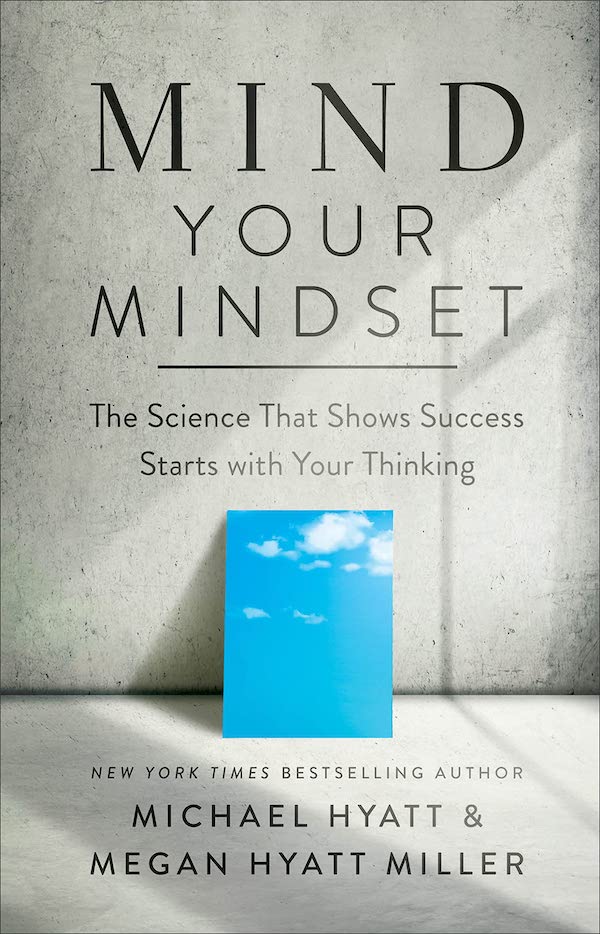Tue, 19 December 2023
Whether or not snow has fallen come December, the warmth and cheer of good tidings appearing about town, the neighbors, in the shops and arriving in the mail by way of the annual Christmas cards sent from friends and family living near and far always wraps me in a figurative hug. This year, similar to last year, I will be spending Christmas at home in Bend, Oregon, and it is exactly where I want to be. And leading up to the festive day has been and will continue to be sprinkled with intentional activities, pastimes and nibbles that create a festive, cozy atmosphere I feel most fortunate to be able to savor. Each of us will go through seasons in our lives, stepping out of old chapters and into new ones when we embrace our courage to welcome what is awaiting to be given to us, and such is the case for me that I am delighting in quiet Christmases. As Nigel Slater eloquently writes in The Christmas Chronicles, in his delicious, image evoking prose, "Christmas is celebrated by Christians and non-Christians alike. It is a cultural event as much as a religious one". I share the rest of the quote in last year's holiday episode - #347 if you want to have a look, but part of why Christmas and the entirety of November and December is treasured by so many is that it is celebrated around the world and it is celebrated by people of a variety of different beliefs or non-beliefs, and that is a reason to smile and appreciate the season all the more. Perhaps inspired a bit by Beth Kempton's beloved book that I know many TSLL readers have enjoyed and return to reading each November and December, and adding to the list shared last year, episode #347, that included 9 Ways to Savor Christmas at Home, Alone, Simply Luxuriously, I wanted to share today's episode of how to savor a quiet Christmas with as few or as many people as you desire, and reveal how these thoughtful ways to enjoy this special time of year, while not extravagant, complex or even requiring money, can bring a deep richness to the season, making it all the more special. Let's take a look at the list. Visit the Show Notes: |
Tue, 5 December 2023
"My mission in putting the single at heart on the map is to rewrite what it means to be single. Single life, to those of us who are single at heart, is a joyful place, a place to learn and grow. It is a big-hearted, expansive, meaningful life full of possibilities . . . intimacy, to us, is personal; in that domain as in all others, we follow our hearts rather than the cultural rulebooks. We chart our own life courses, with meaningfulness, psychological richness, and authenticity as our guide." —Dr. Bella DePaulo, author of Single at Heart: The Power, Freedom, and Heart-Filling Joy of Single Life Joining me on the podcast today is a guest who has courageously chosen to share that she thoroughly and unapologetically savors living a single life. The leading expert on single living, Dr. Bella DePaulo dispels the myths that pervade modern-day (and historic) cultures around the world when it comes to being single by looking at the research that is often cherry-picked and misleading as it speaks to in what type of relationship status one finds the most happiness. But most importantly, in her new book that was just released yesterday December 5th (2023), Single at Heart: The Power, Freedom, and Heart-Filling Joy of Single Life, she focuses on an abundance of findings that reveal the many benefits of living single. From improved health and deeper life satisfaction as we age. Thankfully, so much of what is portrayed in media - films, books, television, pretty much everywhere - is not an accurate depiction of where and how happiness is found. By no means is Single at Heart an anti-marriage or anti-couple book, but rather a book that reveals that those of us who have chosen to be single, who find it far more fulfilling than being in a traditional couple, need only trust our inner compass to continue to choose the life that brings us fulfillment. As she points out, the world would be far more peaceful and content if we would trust what we know to be true of ourselves - those who wish to be in a couple would find people who truly wanted to be in a couple, and those who savored their single life would not feel forced to choose a life that was not nourishing. Tune in to today's conversation where we will talk about the priority and value of freedom as well as benefits of solitude for the Single at Heart, and also speak to how those who are widows/widowers, as well as divorcees, can step into a new chapter of revelation about where and how joy can be cultivated. Dr. DePaulo discusses the importance of nurturing The Ones rather than just The One and reminds us that courageously saying we love our single life is what is needed to change the view that the culture errantly holds on to. |
Tue, 14 November 2023
Satiation. To completely satisfy your appetite, whether it be literally, therefore with food and drink or figuratively as we seek to fulfill our needs in all immeasurable areas of life. To equate contentment with satiation is somewhat accurate except that satiation requires us to engage with something outside of ourselves, to choose well, to know much about what and why we are pursuing it, and thus to know ourselves and physiology well. Granted, the 'knowing ourselves' is a shared cross-over between contentment and satiation if we are to attain either which is why when I began to ponder today's focus of making our everydays taste better, I naturally began thinking about the literal sense of 'taste' as it appeals to our palate, but then began to expand the breadth of 'tasting better' as it pertains to how we move through our days - the decisions we make, the structure, the rituals and routines. And with holiday feasting just around the corner as well as a new year that often brings with it a reassessment of how we are caring for our health, I thought today's episode a wonderful topic to explore because we really can eat well and deliciously all year round, thereby elevating the taste of our everydays. Let's take a look at simple, yet dependable ways to ensure what you cook and eat will satiate your appetite.
|
Tue, 31 October 2023
A quiet confidence, an ease of being. A deep joy of living each day. To consciously find ourselves in any of the three states of being above, it will have taken much intentionality, effort, patience and compassion. As well as strength, courage, kindness and trust. And these are all actions given to ourselves, let alone to the people and environments we engage with along the way to reach each or all of the aforementioned states. However, as Steve Jobs succinctly shares above, once you arrive at the simplicity, you have gone through much complex exploration, and it is because you have gone through that exploration that you know, absent of ignorance, that indeed what that true simplicity is and how to attain it. It is then at that point you really set yourself free and yes, his metaphor is apt - you will be able to do things you may have never thought possible, experience things you once thought only resided in your dreams. When The Simple Sophisticate podcast premiered back in September 2014, in the first episode, we dove right into sharing the eight pillars of living simply luxuriously (the most downloaded episode in the show's history); however, I think we are long overdue for sharing exactly what constitutes someone who is a simple sophisticate. And while I concisely shared a definition on the podcast page: The simple sophisticate is someone who prefers quality over quantity, sensible living over mindless consumption, personal style instead of trendy fashions, has an insatiable curiosity for life’s endless questions and a desire to live a truly fulfilling life rather than being led around by the nose, and the term itself 'simple sophisticate' has simple in its title, but it is in fact a complex concept, a destination and a way of living that takes time at which arrive; however, once we arrive and attain clarity in the understanding of what a simple sophisticate is and experience it first hand, the benefits, the elevation of the quality of our life, we then wholeheartedly understand the invaluable, yes, complex journey of self-discovery and self-growth we needed to travel in order to arrive at a state of being a simple sophisticate. And similarly to living a simply luxuriously life, the pillars for being a simple sophisticate are concrete, but how each of us embodies and welcomes them into our lives will be unique to our own life journey, and nobody will be exactly the same. So to be clear, a simple sophisticate is not a simpleton, and in fact, polar opposite of such a descriptor. A Simple Sophisticate, as we will share in detail below, chooses and acknowledges that many lessons and skills are needed to be able to experience the deep contentment within, but in accepting this truth, now has a focus that will lead through the temporary complex journey in order to arrive at a state of simplicity, a dynamic resting place of clarity, inner peace and a quiet confidence in how you go about your daily life. So remember . . . "Simplicity does not precede complexity, but follows it." —Alan Perlis And it will indeed follow it if you are willing to grow, to stretch, to explore, to let go of control and find comfort in uncertainty. Let's take a look at the 14 characteristics of a simple sophisticate:
Direct download: 368SimpleSophisticate14characteristics.m4a
Category:happiness -- posted at: 8:00pm PDT |
Tue, 17 October 2023
"The fastest way to a good life, is to slow down." —World Institute of Slowness in Norway Walking into a beautifully decorated home, an abode that welcomes you, gives you a hug and invites you to stay without saying a word takes time to curate. And even those homes that someone else has curated and we feel this way when we walk across the threshold into their home, it is their home, and not our own, filled with choices, items and details that they will appreciate more deeply than we ever could, even if we can understand why they appreciate it. All of which is to say, curating a home for ourselves that gives us a hug each time we return home will take time, and so it is in our practice of patience and trust that the house will reveal what we need in time so long as we live consciously and feel our way honesty through living well in our homes, that we gradually begin to see and then feel how wonderfully loving and comforting a slowly decorated home can be to elevate our days and thus our lives. Now, if you when you see the term ‘slow decorating’ you think to yourself, but I want to feel comfortable in my home now. I cannot live without basic comforts. I hear you and I completely concur. Which is why it is important to keep this approach of slow decorating in mind even more. Suzanne Imre from Neptune shares, “Slow decorating is about planning, considering, refining. It’s about having a strategy. A direction of travel, which helps clarify those decorating decisions (light or dark? Nickel or brass? Wood or tiles?). And it’s about enjoying the process as much as the results.” And so it is with today's episode/post, I would like to give you 10 tips to provide exactly that, your strategy moving forward. Choosing to go the route of slow decorating is also a planet-friendly approach. Imre goes on to say, “This slower method also supports the desire for sustainability and preservation. If you have an unhurried approach to furnishing your home, you’ll likely buy less but better. And those pieces will have longevity.” This concept of quality over quantity has been the founding principle of living simply luxuriously and what inspired the TSLL blog coming to be, and it is just this concept that will serve us well, but also the planet should we choose to trust that with time, many benefits for many entities, ourselves, talented artisans, and the environment will be enjoyed. While I have known this concept to be worth putting into practice and have put it into practice with the three year journey of customization of Le Papillon as shared in this episode, I saw with my own eyes how choosing such an approach over years can create an amazingly special place when I had the opportunity to stay for a week at British interior designer Rita Konig's North Farm in Durham, England. |
Tue, 3 October 2023
Britain is calling, and if it is calling you as well to hop on an international flight and cross the Atlantic or the English Channel, or whichever body of water you will have to cross to arrive on British soil, this is an episode I think you will find helpful to ensuring you have a wonderful trip to your destination. So that I don’t repeat myself, I wrote and shared a detailed 17-point list on how to prepare for international travel in episode #183. This list is for traveling anywhere internationally, not just Britain, but it is definitely a list I always refer to before I head out the door at Le Papillon to France or Britain. Today what I would like to share with you are more specific tips and insights for traveling to Britain specifically so that you can enjoy the journey to your accommodations as much as the trip itself once you arrive. Assuming you have your passport all squared away as well as your Global Entry pass should you wish to utilize this swift admissions through security, let’s talk about everything else (again, for general preparation for international travel, check out episode #183). |
Tue, 19 September 2023
"Our world is dominated by algorithms — by data collection that steers us toward a limited set of products and designers who have paid for the privilege of coming up first in our search. The result is that our taste has gotten . . . only more homogeneous, more limited." —Rachel Tashjian, style contributor to The Washington Post, in her article Whatever Happened to Having Taste? The primary reason I wanted to begin with this quote is because the reality is all too real: good taste is often hard to find, and much of it has to do with remaining inside the box. Often this 'box' is the one we see frequently on Instagram, Pinterest or TikTok. Enter interior designer Heidi Caillier, someone who didn't and doesn't play by the rules of social media, who didn't follow the trends, and trusted her own voice and eye. To walk into a home curated by someone with exquisite taste, time seems to vanish, and the primary emotions one feels are comfort, awe and appreciation even if we don't know at all how they did it. Somehow, it all just works. A symphony of hues, textures, pieces, and details that appear as though they just belong together to welcome the residents of the sanctuary home each time they cross the threshold. I remember seeing interior designer Heidi Caillier's work for the first time. It was the cover story of Rue Magazine in 2019. Caillier had designed a Seattle cottage guided by the charming Scandinavian aesthetic - simple, yet cozy, unique, yet functional, and with thoughtful touches of vintage to create a feeling of nostalgia. I became even more intrigued when I saw her work on a handful of Arts & Crafts houses both in California, Oregon and across the country on the east coast. Heidi was speaking my language (she embraces wallpaper!), as she incorporated the aesthetics that reminded me of English country with modern sensibilities for living well and thoughtfully. Check out a few of the homes here (one of my favorites - the kitchen!), here and here. And her entire portfolio here. As Caillier is also someone who lives in the Pacific Northwest, in Tacoma, Washington, part of my intrigue was her home base as rarely had I seen an interior designer from PNW that has their own aesthetic that wasn't wed to the stereotypical Portland or Seattle modern trends that never quite captured my definition of timelessness or comfort, or even warmth. With delight and immediate appreciation, I began following her on Instagram as she share glimpses into her projects as they begin, are in progress and eventually are completed. As she shares in her new book, just released on September 5th, Memories of Home, the portfolio shared in the pages of the book tells stories that are "nostalgic, romantic, creative, playful but sophisticated, and so incredibly comforting." All the boxes in my ideal of a sanctuary are ticked with that sentence, and indeed each home showcased demonstrates her objectives have met their desired results with each client's home shared, including her own. As timing would have it, the topic of good taste, and the seeming lack thereof arose this month in an article written by style contributor to The Washington Post Rachel Tashjian, as I was pouring through the pages of Heidi's new book, it became immediately clear she understands and brings forth good taste in each of her homes, but how does one do that? Even if we don't hire someone or are unable to work with the talent and expert Heidi provides, how do we curate a home, and in very much the same way, curate a wardrobe and a life that is not guided by algorithms? Well, I think that question in and of itself is a great place to start. Let's take a look at eight key aspects of curating good taste when it comes to our décor. |
Tue, 5 September 2023
Prevention versus correction. For a few decades now, or perhaps more than a few, stress management has been the term of phrase often used as we find a culture, and more specifically, ourselves nearing or reaching burn-out whether in our jobs or life in general, and while bringing healing and remedy to something in our lives that needs our attention for improvement is certainly valuable and a necessary skill to learn should we find ourselves in this state of fatigue and chronic stress, preventing such a state from ever being reached is a far more beneficial approach, and gives us much more enjoyment and yep, contentment for a far longer time throughout our life journey. Similarly to stress management is time management, a term of phrase again that is used often but actually brings our attention to the wrong place. Living simply luxuriously is a drilling down and investing in quality over quantity, and this includes how we go about our days. Time management shares directives on how to squeeze more into the day, but energy management teaches us how to thrive throughout our entire day, something the former doesn't prioritize although it does keep it in the equation. And here's the important detail to keep in mind, energy management is going to be unique to each of us because we are each unique individuals traveling during different periods of our life journey, experiencing different chapters of our life, so to focus on time management is to focus on a logical, concrete approach, but we are not stoic, robotic individuals. We have ups and downs in our moods, our physical abilities, our mental strength for focus, will-power, etc., and that is why shifting to energy management will actually solve the issues that stress management and time management are trying to address, but also ensure you are honored for the individual that you are. Let's take a look at six habits to consider when managing your energy well through the day in order for you to thrive, enjoying each day even attending to tasks that are have-tos. |
Tue, 15 August 2023
 When I knew I would be sitting down to chat and catch up with the lead vocalist of the jazz band The Hot Sardines, Elizabeth Bougerol, I knew our conversation would be enjoyable, inspiring and much like taking a drink of refreshing water that leaves you energized, hopeful and inspired. And indeed that was the case. 😌 To talk with Elizabeth, now our second time (listen to episode #157 for our first conversation), is to talk with someone who knows and is passionate about her craft and the genre of jazz; in other words, the history of jazz. And it is because of her passion, along with her unquestionable talent of being born to do it, paired with fellow co-founder of the band Evan Palazzo, the pianist of the ensemble and his equal passion and talent for what they do, that more and more people who tune in to The Hot Sardines' music, and attend their concerts, are discovering and loving jazz all over again or for the very first time as you will learn about in our conversation. Not only will she talk in detail about a handful of the songs on The Hot Sardines' new album C'est La Vie (released wherever and however you enjoy your music on August 4, 2023), but we'll talk about the difference between French jazz and American jazz which I found fascinating and also further revealing as to why I am enamored with the French culture. We will also go beyond the album to talk about work-life balance, what it's like to perform on stage while pregnant and how she answers the ever common question often raised, oddly, nearly exclusively to women who work, about Mom Guilt. I so enjoyed her answer, and I think you will as well. Lastly, we talk again about finding the courage to pursue a passion project, and she offers advice to anyone who is considering doing so but maybe hasn't taken the leap just yet. I do hope you enjoy this episode which will also include three clips from the album that offers both French and English tracks, originals written by Bougerol and Palazzo and covers of beloved jazz favorites. Now to the episode!
Buy the new album C'est La Vie from The Hot Sardines here  Links mentioned in the episode:
Listen to Elizabeth Bougerol partner up with Bob Parins in a duet covering Edith Piaf's classic "La Vie En Rose".
Listen to our first conversation together back in 2017, episode #157, talking Passion Projects, Jazz, Being French at Heart & Living in the Moment 
~Explore more episodes of The Simple Sophisticate podcast here. Photo credit of Elizabeth Bougerol above captured by Shervin Lainez.
Explore all posts shared during TSLL's 8th Annual French Week here
 |
Tue, 1 August 2023
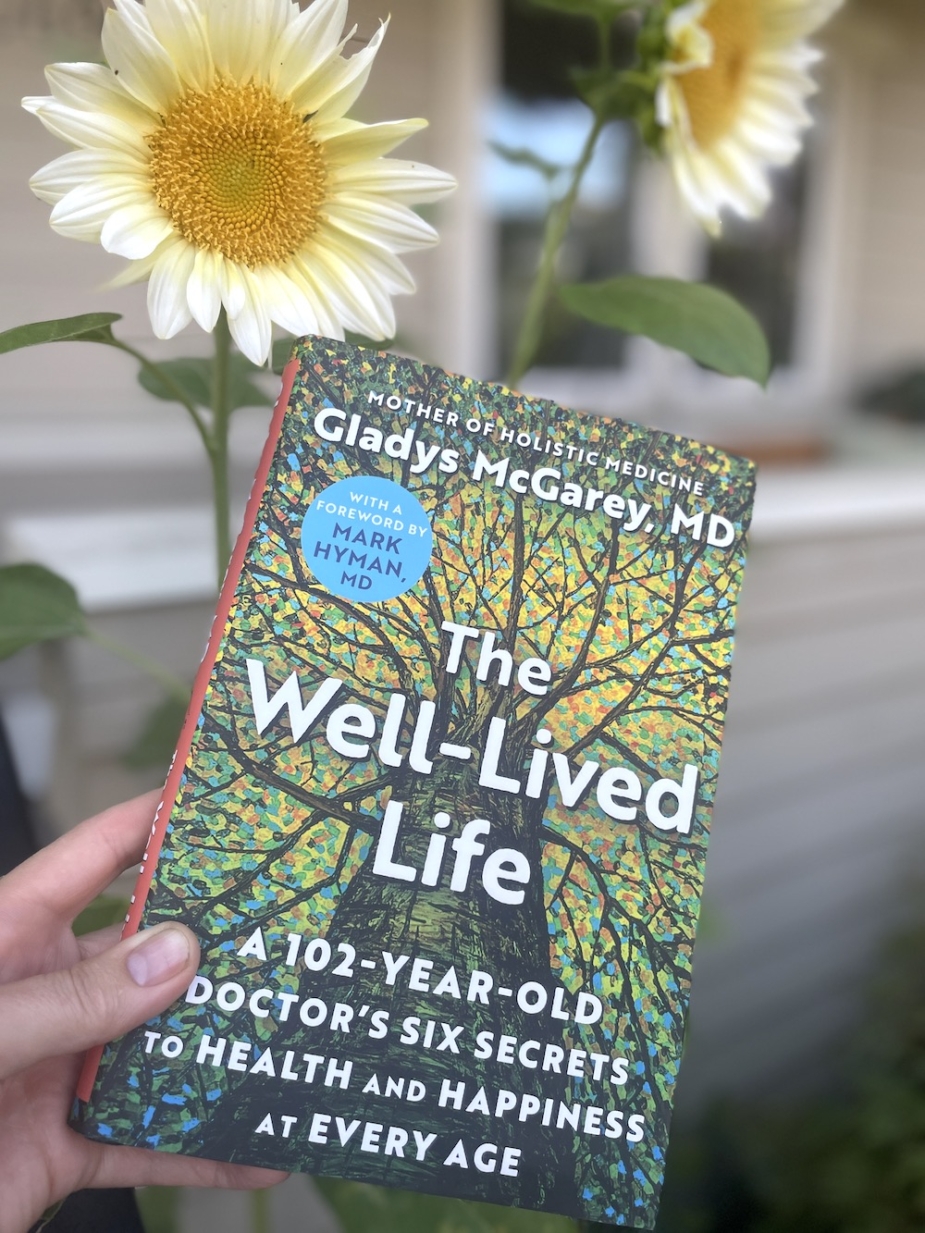
"I still have yet to discover a secret ingredient that has been proven to ensure a long and healthy life—well, not one you can put into a blender, anyway. But I can help you discover the secrets of true health and happiness . . . they're based on a simple shift in perspective."—Gladys McGarey, MD, author of The Well-Lived Life: A 102-year-old doctor's six secrets to health and happiness at every age Born in 1921, Dr. Gladys McGarey's life journey began living and experiencing the life truths she later learned contributed to her living her long healthy and happy life. A doctor in holistic medicine for over 80 years, Dr. McGarey's life story in childhood and young adulthood reads like a history book now taught in classrooms. In 1930 as a young child, while on a train from Delhi to Bombay (now Mumbai) with her family who was returning to the states after having lived in India for some years, she witnessed Gandhi's historic salt march. As she worked her way through school and became a doctor, she battled with cultural norms of where a woman's place should be, and as life continued to unfold, having honored what was speaking to her about what brought her to life even when others disagreed, she continued to witness truth after truth of the medicine one receives when they trust their heart. Released on May 1st of this year, Dr. Gladys McGarey's book is a treasure of inspiration, backed by science of the power of honoring your language of how you find life in living. Below I will be sharing 11 insights and ahas that she teaches that perhaps will inspire you to trust what your heart is saying even if you don't know what will transpire. "Part of what makes mysterious happenings possible is our belief that we don't know everything . . . I cannot overstate the importance of keeping a sense of wonder about the world as we age. It is what keeps us young. Our souls benefit from our holding on to the idea that we don't know what's going to happen next." Let's get started. 1.Find your life force "To be truly alive, we must find the life force within ourselves and direct our energy toward it." Dr. McGarey calls it our "juice" and explains that "the process of finding our juice that keeps us vital". She shares that in many Eastern philosophies "there is a certain energy tied to well-being", two terms used to describe this are prana as well as chi. Western philosophers often use the term purpose or motivation. She continues to remind that while finding our juice and cultivating it won't "ensure perfect health, running out or losing our juice is often a major obstacle to feeling good". When we don't find our juice, both our mental and physical health start to wane. Finding what your juice is may shift and change over your life journey, but keep yourself in the process of finding what lights you up, what makes you feel energized when you are engaged in whatever it is you discover. That is your juice. That is your life force and it is immeasurably powerful to living well. Multiple studies at the University of Michigan Health and Retirement Study "observed a link between a high sense of purpose and decreased mortality in adults over fifty." Similarly to what Dr. McGarey shares, when we find what is our purpose, our calling, our prana, whatever term you want to give it, the world receives this positive energy, and not only is our well-being improved, but so too is the world's. Why? "The joy [finding our juice] brings to our lives will ripple out to the world around us".
2. Know this to be true: You are as you are and that is an awesome thing "We're supposed to be shaped precisely as we are, because that way we can fit together. It isn't anyone's job to judge the shape of anyone else's piece, and in the same way, it isn't useful to try to make ourselves more or less like anyone else or to worry if they judge our shape." What Dr. McGarey then reminds us is for each of us, knowing that we are made the way we are for a reason to give something awesomely unique to the world, to contribute positively in a way only we can, it is our responsibility to find it, embrace it and share it because "each of us is essential". And when we tap into our truth, our true self, we inspire others to do the same in their own lives. "When we feel ourselves click into the whole puzzle, we become part of the pattern of life. When this happens, we exchange juice with the world around us. Our juice flows freely, and we have more of it than ever before."
3. Multiple streams of 'juice' "We're able to connect with life best when we get juice from multiple places. A puzzle piece doesn't just click in on one side; it clicks in on two, three or four. What that looks like varies from person to person ." When you find your juice, you may think it will be one thing, but in actuality, our life is full of multiple sources of inspiration and energy, and each, when consciously chosen using our self-awareness to ascertain what fuels us and what drains us, we can cultivate a life full of juice. From our work, to our relationships, to our hobbies, to how we nourish ourselves. McGarey speaks in this section about how the 'should's from the culture that surrounds us can make us involve ourselves in life choices that 'should' be the best choice when such advice is incorrect, even though perhaps well-intended. Her example that she uses is choosing to be a parent. While she herself loved and loves being a doctor, she also loved and wanted to be a parent. Being both during the mid twentieth century was scoffed at, but to her, working as a doctor was her juice, but so too was being a parent. She dismissed what others said was 'best' and honored what gave her energy. But raising kids and being a parent isn't going to be a source of juice for everyone and that is vitally important to understand. I use the example of being a parent because it is a common one purported as including, "well, of course it is exhausting - that is what parenting is!" But I say this most sincerely as a teacher who met many hundreds even thousands of parents over my 20-year tenure - for some people it drained them, for others it lifted them. It isn't being a parent that is the medicine for a happy life, it is choosing what is discovered to be your juice and for some that is parenting, but not for all. I so appreciated her pointing this out and sharing her own experience as a parent that indeed, it isn't something that everyone will find to be their purpose and honoring that is vitally important to living well. For me, I knew this pretty quickly, but I was amazed, especially more upon reflection, how adamant society was to tell me I was wrong, even though they had no idea what made me fill inspired and full of energy. That is all the more reason to trust your own journey, your inner voice, your soul as many call it, and keep searching until you find your juice. You will know it when you come across it, and as mentioned above, there will be MANY things that will give you juice. Explore, delight and include them in your life as you will. Some will remain in your life your entire life journey and some will only be a part of your life for a chapter or two, and understanding this truth demonstrates you are living consciously and are aware of what fuels you and what drains you. 4. Embrace movement - physically, emotionally, spiritually "Understanding the power of movement can get us through almost anything. It's a sacred truth that helps us in our hardest moments." From stuck energy to blocked adrenal glands, movement is needed to bring us to good health. Studies continually demonstrate that physical movement, simply walking briskly for ten minutes, increases life expectancy, and such physical activity helps us move through stress and even depression. Why? Through physical movement, the brain is signaled "to release feel-good hormones and these have profound effects on both short and long term health." From our mood to how our brain's cognition improves, movement is good and that includes forgiveness to release stuck emotions, moving through fear, anger and disappointment is beneficial to our mental health, and thus why understanding how to become aware of our thoughts is crucial to understanding how they either impede or improve the quality of our life. If the former, it is time to make a move to learn something new to change what is thwarting our ability to let go of certain emotions we are stuck in.
5. Understand a necessary transition period may have to be traversed Dr. McGarey points out that when you do find your juice, it is likely that you will have to, in order to do what you love doing, what brings you to life, "go through a transition in life. It shows us who we really are. This may require us to make a change, start doing something new, or stop doing something we've done for quite some time". It may not be a dramatic change, but merely a changing of the stories you tell yourself, how you engage with the world or the habits you have been incorporating into your daily life, but it may be a significant change - a job change, relationship change or shift, a move. When you find out what you can uniquely give to the world and what the world engages with as you give a positive contribution that only you can give, you come to see that indeed you have a gift within you that needs to not be tucked away. Dr. McGarey writes "our search for juice connects us to the greater question of why we're here?" She goes on to address that this is regardless of whether you have a formal belief structure or not, so whether you are spiritually or religiously inclined, atheist or agnostic or anything that guides you in life. When you find your 'why' you have found your juice and that is the 'medicine' for a healthy and long life IF you choose to engage with it. Sharing that after her own divorce from her husband who she had been married to for decades and shared six children, it was when she stepped away from a marriage, that for some time was filled with much love and goodness, that "life got a whole lot better from there . . . I became who I had always been meant to be." It is when we cling to what we know that no longer serves us or never served us that cause us pain and prevent us from healing. And the healing can only take place when we embrace our life force and trust what it will bring into our lives.
6. Bravely be love "Our life force is activated by love." Fear is inevitable in life, in many forms, but it is when we choose to remain in this state of fear that our lives are adversely affected. Dr. McGarey reminds that "Fear destroys our sense of reason, making it impossible to see things clearly." And here is the good news. When we acknowledge fear, but don't linger in this state of feeling, but instead take action, either through asking questions, asking for help, or at the very least stop digging more of a fearful hole for ourselves by spiraling into more worry, we begin to step ever closer to finding our juice. You will appear fearless, but not in a daredevil way. But rather, as McGarey writes, as "a person who approaches life with an open heart." When we open our hearts, we are opening our lives to love. It can enter our lives in any number of ways from the kindness experienced from others, a smile, or support as you make your intentions known and bravely pursue your calling.
7. The importance of self-love "When we refuse to love ourselves, we shut out love from everyone else, too . . . Self-love is not pride at all. It is gratitude for the life we have been given." When we finally remember that we have always been lovable, "that is when we become "love-able". In other words, "self-love is the basis of all love". This will require us to step away from, let go of, choose differently so as no longer to include, parts of our life that want us to believe we are not lovable or not wonderful just as we are, that what lights us up is wrong, or lacking or not enough. Dr. McGarey uses the example of the tumor that needed to be removed when she had breast cancer, in order to be loving to herself, to give herself life, she had to remove the tumor. Instead of fearing cancer, she honored herself and her body, by being loving and removing it. She goes on to talk about telomeres (the end caps on our chromosomes), and how studies have revealed they are affected by our thoughts. Simply put, positive thinking, which involves the thoughts we think about ourselves and whether or not we are deserving of love, beginning with regularly giving ourselves love that includes honoring what gives us vitality and juice, "does affect the way our genes express themselves, which can have profound effect on both our health and our experience of being alive." Wow! IF that isn't a reason to cultivate a life of vitality and honoring our true self and purpose, than well, just wow. :) Thoughts create images in our mind, and depending upon what those thoughts are, we are either healing or hurting ourselves. Our life force, as discussed in #1 is a powerful healer when we embrace it and welcome it into our lives.
8. Connect and contribute what you uniquely can "Life comes from our connection, is supported by our connection and creates connection. We are happiest and healthiest when we are contributing to and drawing from our collective life force." Positive social connections are crucial to our overall well-being and good health. And when you have found your life force and are bravely sharing it with the world, more energy is created. On the flip-side when you are drawn to others because of what they are giving to the world, you're connecting with them, and supporting their journey is equally energizing to both parties. The key is yes, connect, but connect through what you can uniquely offer. This takes bravery because you are making yourself vulnerable, but you are also tapping into supporting others in ways you may never know which is why when someone or something speaks to you, supporting them genuinely in ways that are welcomed and you can partake is a priceless gift given and received. With that said, finding friends, again creating connection, is awesome medicine, but also not something to be rushed or forced. McGarey suggests start with your neighbors and then move on to people you work with or network with at work by simply being kind and curious. When you are living your life force in everyday life, more serendipitous meetings will occur, "pushing new people your direction", we simply need to remain open to seeing them. With that said, we need to actively be aware of how we feel and how our juice or life force responds to new people that cross our path. If anybody is draining our juice, this is when we need to honor our boundaries.
9. The importance of boundaries "Setting boundaries starts with knowing who we are and what we came to do. We must first understand what gives us juice and what drains it, because that shows us what's on our soul's path and what's interfering with it." Boundaries is a topic we have talked about in depth here on the podcast (episode #343), so I encourage you to listen/read that episode/post for specific tips and tools for understanding how to set and know what your boundaries need to be. However, to begin with, in order to have the right boundaries, "we have to know ourselves really well" as Dr. McGarey shares. Boundaries in our life are a bit different than boundaries as we understand them when it comes to sovereign states for example, but not really if we look more closely. Boundaries are set to honor what we need in our life to flourish, and as we grow and change, and life and other people are dynamic as well, our boundaries will change also. But it is essential that we are the ones moving them, not anyone else. For example, another country cannot tell their neighboring country that the boundaries will change (i.e., the former mentioned country decides to take more land without permission). Nope, that is not how boundaries in our lives work. We have to, upon knowing and discovering what we need, set our boundaries and adjust them as we recognize they need to change to continually support our life journey of living well.
10. Life reflects what you give "When we contribute positively to our collective life force, our individual life force benefits. We find greater purpose and meaning in our days. We understand not only that we are part of a greater whole but how we are part of that whole. We align with what life intended for us to do all along." If you are at a point in your life where you feel life is just not going your way, it is hard, it is constant struggle, and you have lost trust in others, yourself and/or the world, ask yourself the following questions as listed by Dr. McGarey:
She reminds us that "community is a give-and-take relationship" and we can't come to the community with an 'ask' or a demand for a specific outcome. We actually just have to show up with our true selves give with loving kindness while honoring our integrity and while we have clarity in our own life journey, having set intentions because we know ourselves, we can simply let go. We don't know how the support will show up or who you will begin to work with that will involve trust, but so long as we engage with self-love (knowledge of where your boundaries are and why they are there) as well as our life force that brings us to life, we are becoming part of the collective force that creates the healthy connection we need to live well and live a long, lovely life.
11. Lessons are everywhere and in everything "We live our best lives when we approach life with curiosity and desire to learn from everything." Something that was the subject in a recent Monday Motivational post is the idea that even when things look like they may be falling apart, they may actually be trying to help us if only we shift our perspective to see this truth. When we realize that there is a helpful lesson to learn even in unwanted events, the quality of our everydays and thus our entire life changes for the better. McGarey shares, "Life always has new teachings to offer us if we can find the courage to look for them." Admittedly, it will take great courage and inner strength to look for the wisdom that is hidden in the unwanted. But when we choose this path, we are helping our health. Why? "We are moving our attention away from suffering and directing it back toward life". Remember earlier in the list when we talked about movement? If we stay stuck in focusing on what isn't working, what is unwanted, we are not helping ourselves, but stopping life from happening, from moving forward. "Seeing everything [as a teacher] helps us make our life a living, breathing process." Now you might be thinking, well, that is just too Polly-Anna positive for me, Shannon. But I beg to differ. It is actually more realist than anything else. It is accepting what is and choosing to use it for fuel to constructively move forward to give you life rather than drain your life. McGarey concurs, "True optimism isn't toxic, because focusing on the positive does not mean denying the negative. It does not mean we dissociate from our pain, whether it's physical or emotional, or pretend that things are okay when they aren't. Instead, it means we look for what's wonderful anyway. We allow what hurts to hurt while continuing to search for the lesson in it and be grateful for the teaching."
12. Understand what true health is: Steer your energy toward life "True health is about living with the world around us as an engaged, participatory experience." Encouraging readers to 'spend your energy wildly', Dr. McGarey teaches that once we have discovered and embraced our life force, we have an abundance of energy, and now we can spend it by enjoying our lives. And because we gain energy by embracing our life force, we have much to spend as we engage with the world, and so bravely, "tap into [your] deepest knowing", let yourself be who you are and give what you can uniquely give. It will energize you in return and create a wonderful give-and-take relationship that will continue to give you life. With that said, we need to step toward and engage with "things that feel good and help us grow". What energizes you may not energy someone else in the same way or at all. Reminding us that each of us has to find our own rhythm that works best for us, as well as remembering to adapt to it as what we learn and as life unfolds reveals is best moving forward. And don't forget, choosing to and needing to rest is indeed an action. We all need to rest. This is a nourishing self-love practice that is necessary. Some may say resting is being lazy. Dr. McGarey disagrees writing, "Being lazy is when we withhold our life force from the collective; it's when we hold back, refusing to give, refusing to participate. This drains our juice. The purpose of resting is just the opposite. When we rest, we're consciously dedicating our energy toward what's most important to us."
13. Turn toward life, your life and what makes you come alive "Learning to listen to our own inner knowing is the key to discerning, in any given moment, how and where to invest our life force. And it takes truly living to understand this. We're meant to interact with our lives. The work of life is simple: We must try and fail until we succeed." A truth that is shared repeatedly here on the blog/podcast and in different phrases and words, but all are focusing our attention on the truth that you have something that makes you come alive within you. Find that, and you find your path forward. You won't know what the path will reveal, but follow the vitality that you receive, remember to get to know yourself along the way and apply that knowledge to the decisions you make about what you will explore, who you will dance with and also carry with you the knowledge that, as Dr. McGarey reminds, "you are right on time". Your health depends on you bravely and with an open heart and mind stepping in a direction that brings you to life. The Well-Lived Life: A 102-year-old doctor's six secrets to health and happiness at every age by Gladys McGarey, MD
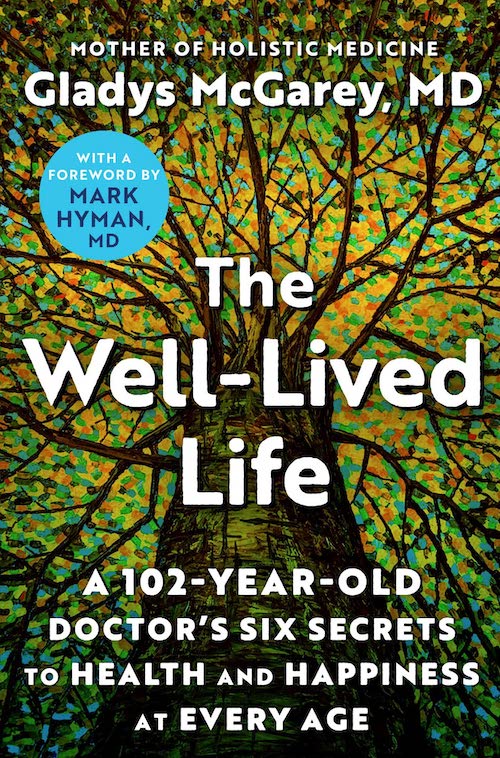 Explore the book, The Well-Lived Life here.
Petit Plaisir
—And Just Like That, season 2 Tune in to the end of today's episode to hear a detailed review of why I recommend the second season of And Just Like That on Max, addressing the critics of the show and sharing why this season dovetails wonderfully with the topic of today's episode.

~Explore all of the episodes of The Simple Sophisticate podcast here. |
Tue, 18 July 2023
The journey of customizing Le Papillon, my house and home in Bend, Oregon, since September 2019 has provided much opportunity for learning both about the actual and practical purpose of home remodeling and decorating but also for self-growth. Over the past nearly four years, an abundance of experiences, discoveries, lessons and ‘wow’ moments have been collected which is why I wanted to share today's detailed and lengthy (90 minutes) episode with listeners of The Simple Sophisticate podcast. As I share at the beginning of today's episode, while it has been a dream of mine to customize my own home, I never actually planned to spend the past four years doing so, but the timing and opportunity presented itself to continue moving forward once my first "must-do" project (the kitchen) was completed, and now with the installation of the front porch screen door you see a glimpse of above, the journey is complete, and I am eager to share with you 33 lessons I have learned throughout the experience, so that you can confidently and more enjoyably take part in your own customization of your sanctuary that will, when you dare to trust what you discover and learn how to do what is needed, provide priceless refuge, rejuvenation, inspiration and joy for the life that brings you deep contentment. No doubt, the journey had its headaches, stresses and questions along the way (for example, when will the bathroom ever get done!), but I share here and in the podcast episode, without any hesitation, it was worth it, to be able to call home and live my life now in a home that works with me, nourishes me and helps me feel secure but also confident enough to try to soar and explore when I step out the door into the world. So let's begin! In the Show Notes below I have only included the 33 bulleted points and left the detailed conversation, examples and ideas solely in the audio section as otherwise, this post would have been very loooooong. To thank you for your patience as there was no new episode on the 1st Wednesday of this month, I have two Petit Plaisirs to share with you today, and I look forward to sharing those with you at the end of this post and episode. Now to the episode!
~Explore more episodes of The Simple Sophisticate podcast here. |
Tue, 20 June 2023
"We think love has to be obtained, earned, achieved, and received. We look for it in the form of attention and compliments, and people acknowledging us. But actually the greatest way to experience love is to give it." —Jay Shetty, author of 8 Rules of Love: How to Find it, Keep it, and Let it Go A simple formula to love is to be it and it appears. However, this seems either too simple for some of us or to not produce the 'type of love' we had in mind. Such thinking, to have a narrow definition of what love has to be in our lives to be fulfilled, or to refuse to let go and just be instead of chasing, demanding, swiping or requiring, is to get in our own way when it comes to living a life, every single day, full of love. Because guess what? Such a life is possible, and it is part of what living simply luxuriously is all about. In fact, it is at the core, because as I will share today, it all comes down to finding peace with ourselves, embracing our true selves and engaging fully with the world without expectation. But again, we are being asked to do less, not more, to look inward so that we can engage lovingly outward as well as lovingly toward ourselves. We are being asked to be honest about what makes us feel loved and stop engaging in practices that result in anything but. Visit the Show Notes on the blog The Simply Luxurious Life - https://thesimplyluxuriouslife.com/podcast360 |
Tue, 6 June 2023
Author and philosopher of contemporary living, Alexandra Stoddard has published 28 books since she began in 1974. Continuing to be a source of wisdom, inspiration and sharing through how she lives that curiosity and forever being a student of life elevates our lives regardless of age, she joins me in a special episode to talk about her life's work. Our conversation of more than 75 minutes covers a wide breadth of content that she has written about over the years, and it's all grounded in how to live well, cultivating happiness and contentment, mindfully living in the present moment and how that daily practice changes for the better so much about all that we cannot control in daily life. From discussing the importance of rituals, to living a life grounded in paying attention to what our senses observe as well as how one can have a happy death as she speaks fondly of her late husband to whom they shared a loving marriage for over 40 years, we talk about many of the topics that are fundamental components to living a simply luxurious life, a life of true contentment. I do hope you tune in and hear the enthusiasm and genuine love of life Alexandra Stoddard embodies and no doubt will inspire in listeners to do the same in their own lives.
~Explore all episodes of The Simple Sophisticate podcast here.
|
Tue, 23 May 2023
 The book I wanted and needed to read. Repeatedly, indirectly and directly women and the entire society at large are told that aging is bad, and it is especially an unwelcoming reality for women, but is this true? Fashion Director for The Times London since 2015 Anna Murphy recently turned 50, and in her new book (being released on May 30th in the states; in the UK it was released in March) Destination Fabulous: Finding your way to the best you yet, disagrees wholeheartedly with this false truth that women have begrudgingly or willingly accepted and explains exactly how each year, each decade can usher in more fulfillment, more life satisfaction and thus more contentment. She joined me from London last week before heading down to Mexico to take in Dior's Cruise presentation, and we had a lovely conversation about everything from the benefits of doing the hard work of getting to know yourself, how your style can bust clichés, the benefits of being age agnostic, how living our best life does physically affect our skin and visage, as well as the false promises made my anti-aging procedures, plus so much more. We begin our conversation with why she is the happiest she has ever been, and with that, I will encourage you to tune in to our conversation. I do hope you enjoy. Links Mentioned in the episode
 Follow Anna Murphy's work on the following channels:
~Pick up Destination Fabulous: Finding your way to the best you yet by Anna Murphy (2023) 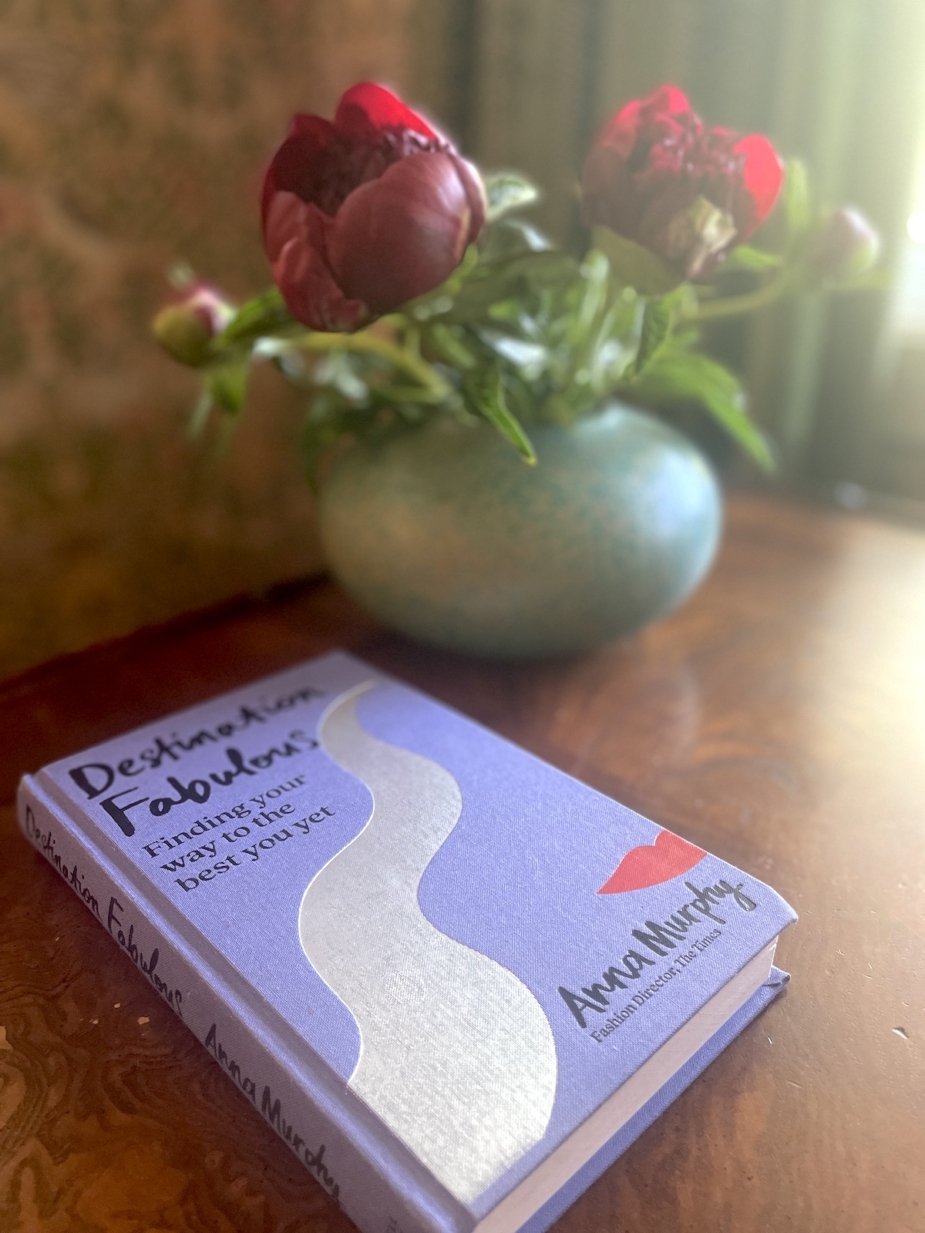 Anna Murphy's book was the inspiration for a Monday Motivational post shared earlier this month.
~Explore more episodes of The Simple Sophisticate here. ~Explore more British-inspired episodes here. ~Explore more Signature Style posts here
Explore all Previously posted content from TSLL's 5th Annual British Week
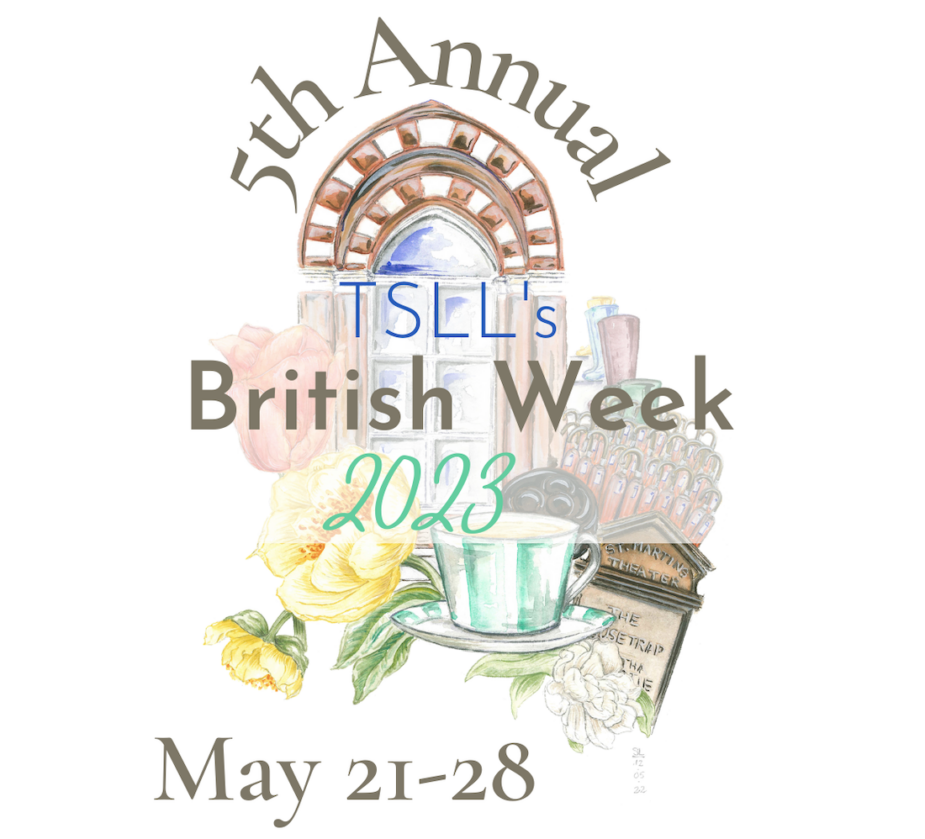 Images courtesy of the author and The Times, London |
Tue, 16 May 2023
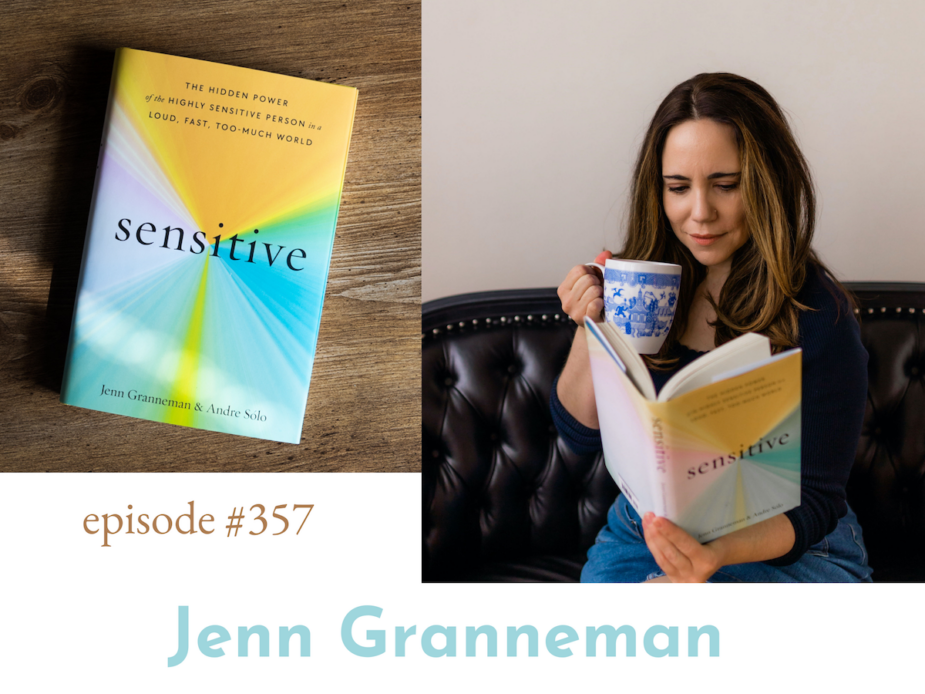 Being a Highly Sensitive Person (HSP) is a fairly new identifier to describe anyone who is highly responsive to their environment. This high responsiveness can appear in a variety of ways and different arenas of our lives - physically, emotionally, in relationships, simply going about our days and interacting with the world around us. In 1996, American clinical research psychologist Dr. Elaine Aron wrote her seminal book The Highly Sensitive Person: How to Thrive in a World That Overwhelms You, and it was in this book that term HSP was coined. Author Jenn Granneman joins me to talk about her new book on this topic of HSP, a book that includes new research that furthers supports Dr. Aron's findings, as well as exploring history revealing that this gift has always been with us, we just didn't identify it until recently, and welcoming in specific insights and tools to elevate this awesome gift that can indeed deep the quality of our entire life. Jenn Granneman's book, who she co-authored with Andre Sólo, Sensitive: The Hidden Power of the Highly Sensitive Person in a Loud, Fast, Too-Much World was released on February 28, 2023, and quickly became a bestseller in the category of Popular Psychology Studies and was recently chosen by Amazon's editor's as the Editor's Pick for Non-Fiction. Today she joins me to talk about what HSP is, the misconceptions, how being HSP is actually a source of strength, how to approach relationships and the work place as well as talking about why she hopes this book starts a Sensitive Revolution.
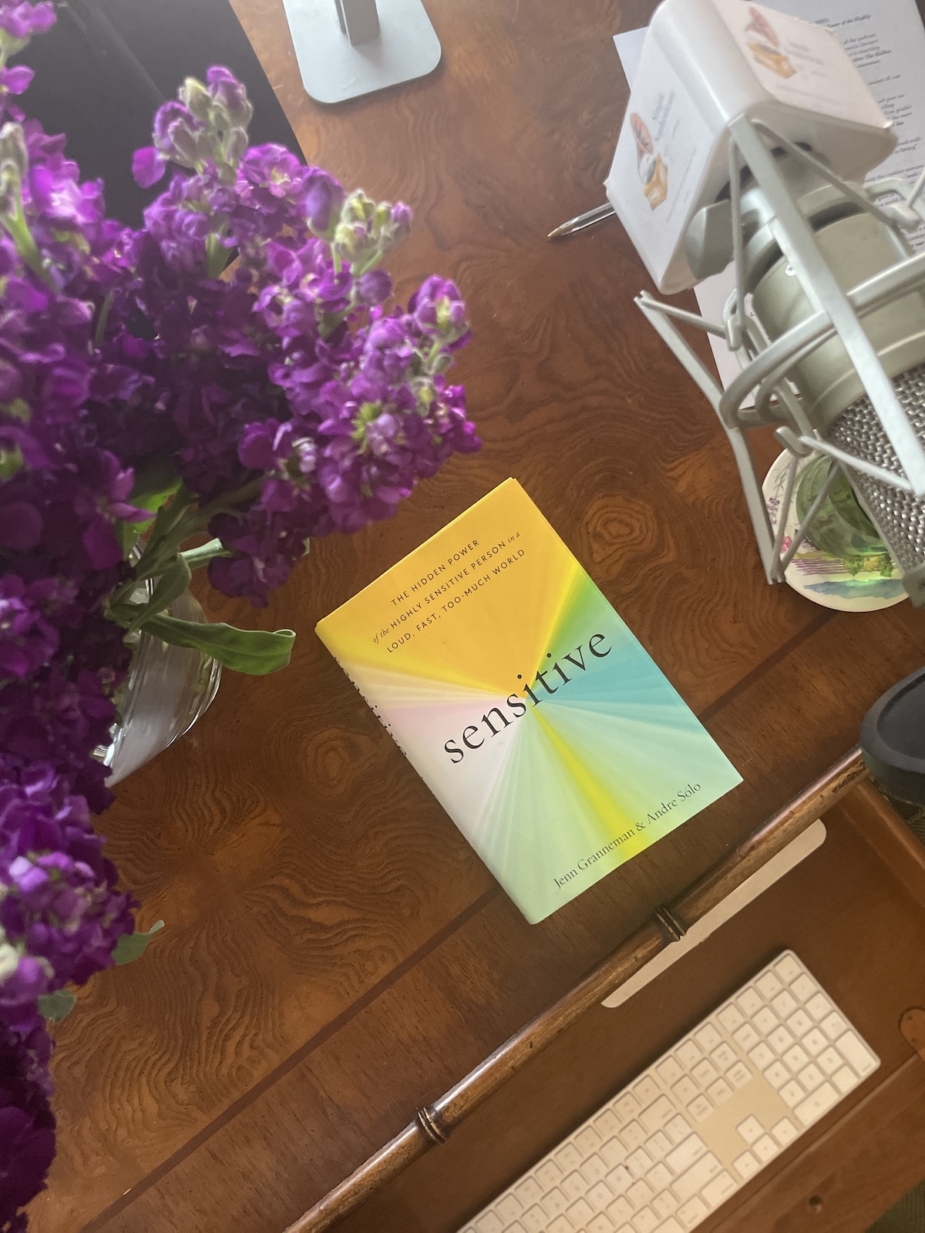 ~Explore the book: Sensitive: The Hidden Power of the Highly Sensitive Person in a Loud, Fast, Too-Much World by Jenn Granneman and Andre Sólo~ Explore Jenn Granneman's websites on HSP and Introversion below, as well as other links you might be interested in:
~Explore more episodes of The Simple Sophisticate podcast |
Tue, 2 May 2023
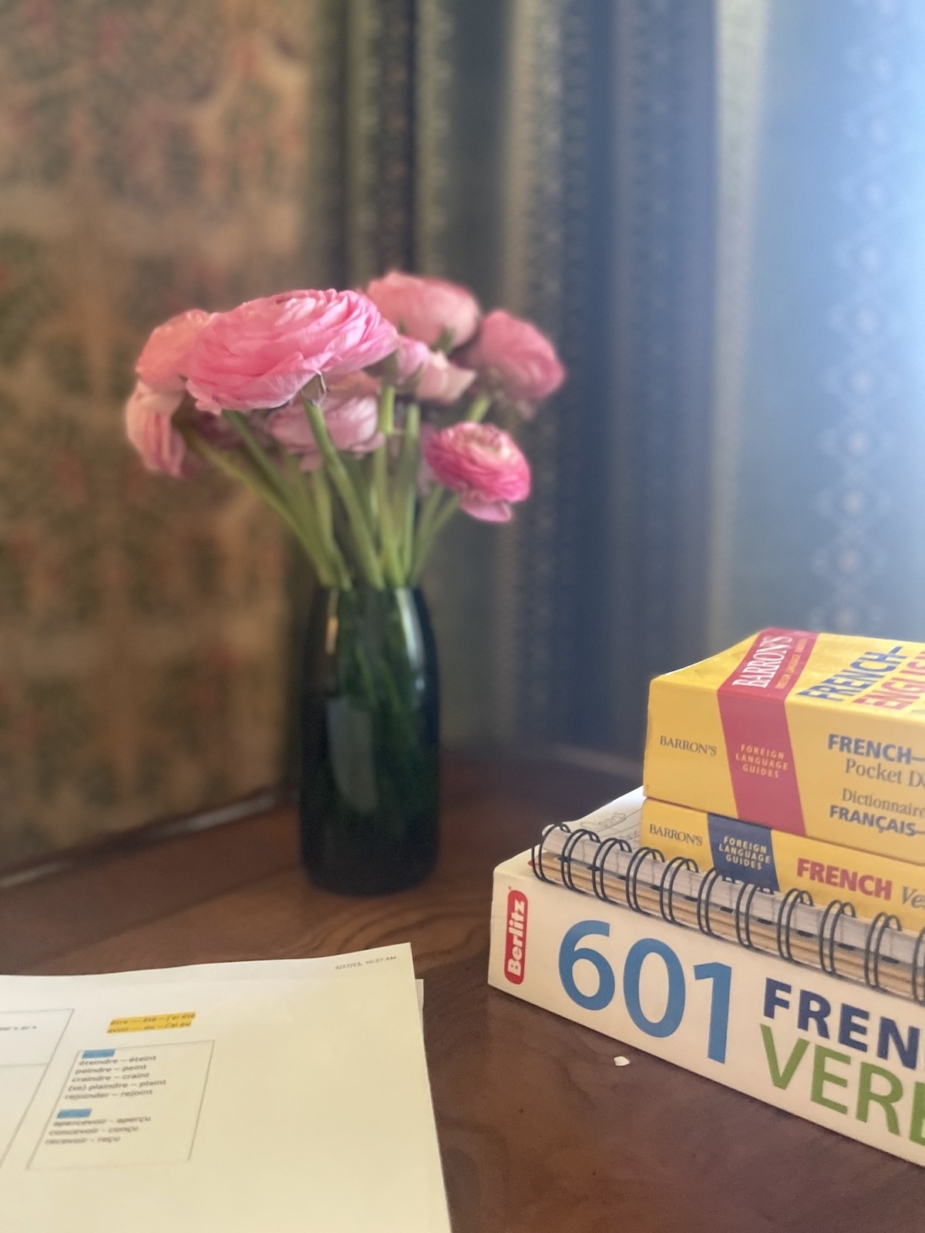
"N'ayez pas peur." And the formal lessons continue into the wilderness and beauty of the French language. Or should I say langue française. And yep, we have just dove into to learning the imperatif form, and as the command directs above in French - Have no fear! Which is a great place to start because when we choose to learn a new language, especially as an adult, and anyone proficient in any field other than the French language, humility must be brought with us on the journey. To trip over any new language we wish to learn, or any new skill for that matter, is a practice in being vulnerable, and being vulnerable is scary. It's scary to try to form the words and say them outloud, even if we have practiced and know the alphabet of our new language. It is scary to bravely raise our hand and attempt to answer a question when we know the answer may be a direct and frank 'no' from the professor. And it is scary to keep raising our hand, to keep speaking the new language, after we have mispronounced and incorrectly answered in the past which is why, it is imperative to hold this directive with us as we choose to learn - Have no fear. After all, what is there to be afraid of really? This is when we need to set our ego aside, take the many (many!) corrections from the professor and just keep trying, just keep speaking and gradually, ever so very gradually, improvements and a depth of understanding as our long-term memory begins to hold this new language in its arsenal of knowledge it draws upon when we least expect it to be easy to grasp, the new language becomes easier. I write the words of encouragement for you, readers and listeners of the blog and podcast as much as I write them for myself because it is a slow journey, but all of a sudden, I will find myself in moments grasping and understanding what to say and how to say it when in the past such an occurrence would never happen. And it is in these moments, I know that the regular effort, vulnerability and bravery (and mental exhaustion) are worth it and are paying off. Today, we return to the series of what I have learned so far in French class. A journey that began in 2016 as I shared in Part Quatre just a couple of months ago (visit that post/episode #349 here) and is continuing as I begin FR 104 (A2.2) with Washington D.C. Alliance de Française having begun with them FR 101 in September 2022. Part Quatre brought us to the mid-way point of FR 102, so today's episode will focus on what I have learned as FR 102 concluded and all of FR 103 which wrapped up in mid-April. Admittedly, FR 103 is when I felt I was in brand new territory as up to 102 I had a clear awareness of present tense, the numbers, basic 'get to know you' phrases, and had been exposed to the components taught, but needed to polish them as well as fill in a few of the fundament gaps (proper pronunciation of the alphabet for example!). So now I am in the thick of new knowledge, and my head is exhausted each week, following each day of classes (two, two hour classes each week). However, well, I am getting ahead of myself. Let's take a look at the list of what I have learned so far in French class . . . 1.The mental exhaustion improves with time As I shared above, when FR 103 began, with a new professor who has high expectations and uses every minute of class, after each week and each class, my mind was exhausted; however, that was the worst of it. In other words, my mind was working in a way it had not, and therefore, had to 'get into shape' by being stretched. Now, yes, I still have mental fatigue, but part of me is used it, but the other part of me knows, my mind as it pertains to learning the French language, is getting better toned and used to searching, remembering and applying the new knowledge. All the more reason to hang in there and keep attending class, keeping signing up for the next class.
2. Être, Avoir, Savoir, & Vouloir are the only verbs that are irregular in the imperatif As hinted at above in the opening quote, we've begun learning the form and function of the imperatif! And it is really quite simple, especially when I discovered (and it makes sense logically) that there are only ever three forms of the imperatif for conjugation (tu, nous, and vous), and so long as you know your Present tense forms, and memorize the four new irregular forms of être (to be), avoir (to have), savoir (to know) and vouloir (to want), you know how to properly use/write/speak the imperatif! What is the imperatif? The exact same thing imperative is in the English language, a command or direction given with an understood subject (so the sentence begins with the verb).
3. How to communicate time properly (formally and informally) A simple concept, but knowing how to form a sentence when asked the time is slightly different compared to English, but it is quite simple. The key is to remember to once you begin speaking the time formally (military time) to continue to do so - only numbers, no phrases; and when you speak heure informelle, then you can use the common phrases - midi (noon), minuit (midnight), moins le quart (less than a quarter - 15 minutes), et demi (half past), etc.
4. What "liaision" and "enchaînement" are as they pertain pronunciation in the French language Large, odd words, but all they are, and they are very important if we want to pronounce the language correctly, is how the sound of the word changes due to the words around it.
5. How to construct passé composé Finally learning the past tense (aka the passé composé) was a big step in my learning journey of the French language. And it is soooooo much simpler than I had anticipated. While I won't teach the entire lesson to you, the key is knowing that every single conjugated verb will be preceded by either être (conjugated to fit the form) or avoir (conjugated to fit the form), and there are only approximately 15 verbs that use être (simply memorize them), and the reset all use avoir. Below are the fifteen verbs that use être, and how I remember them is they are all verbs in which they describe a change of state or motion. Now do note, not EVERY verb that involves motion or a change of state uses être, but all of these in this list fit that definition.
And then, the verb that follows has a fixed ending for all forms (je, tu, il, elle, on, vous, nous, ils/elles, which comes down to memorizing, but most, if they have a certain ending in the infinitive form (i.e. -er, -ir, etc.) end in the same ending for that form. For example, my list captured in the image below:
6. Passé composé is easier than I thought and gives me so much flexibility in constructing phrases It is worth reiterating that again, what I thought prior to learning was incorrect. I just needed to be taught by someone who knew the language. Once I had the knowledge, great progress in communicating was made and ease experienced knowing I could share what I had done in conversation, whatever that may be!
7. Positive encouragement and praise are wonderfully powerful no matter what the student's age
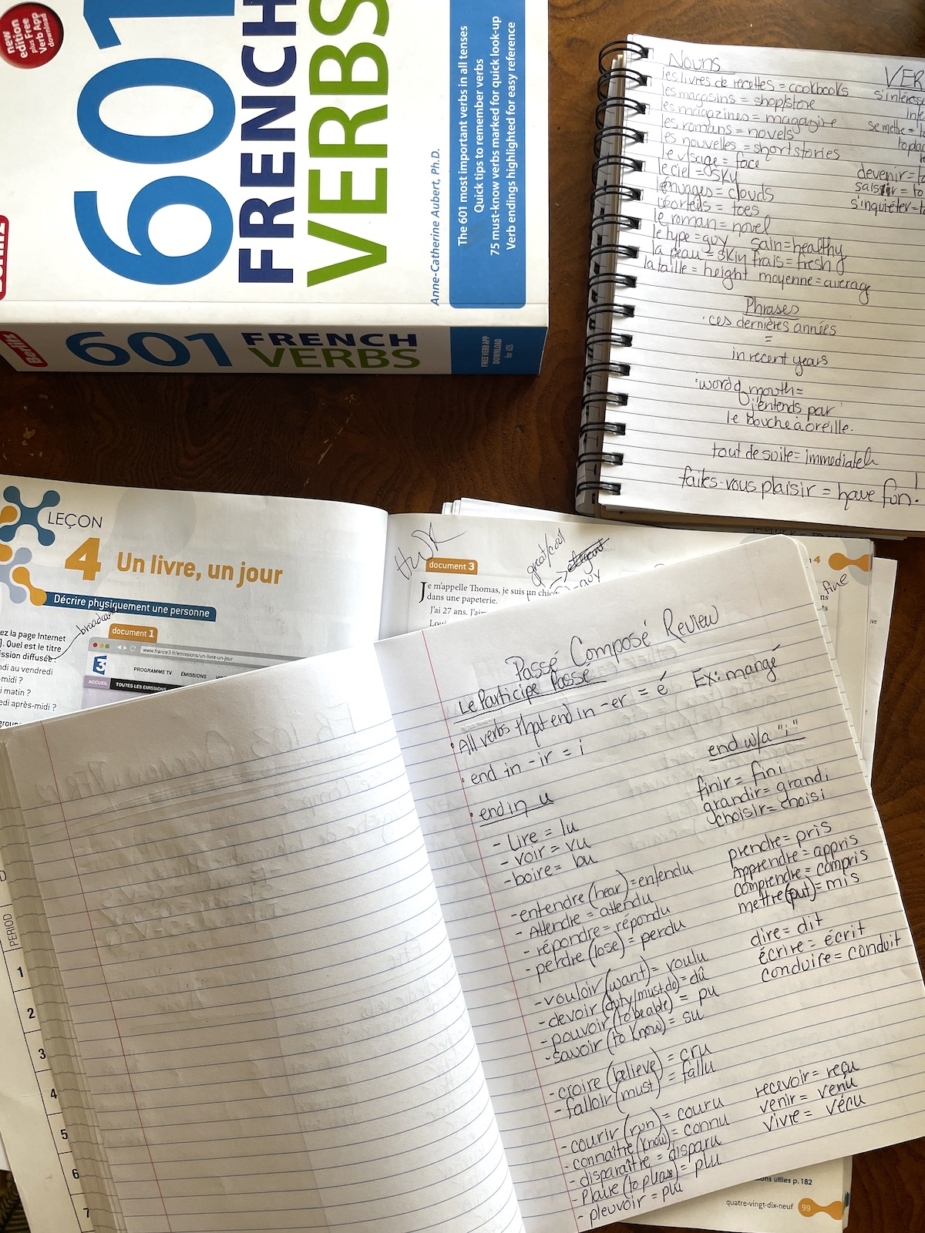 It has been a fascinating experience being a teacher who taught for 20 years and stepping into someone else's classroom who is the expert on a basic subject - the fundamentals of a language. Apart of the skills they are teaching and I am trying to learn, the energy and connection a teacher brings to the space determines the probability of their students remaining in the class, believing they can do it and the confidence to try. As well, a teacher is a human being, and it is easier to notice when my professor is exhibiting an immense amount of patience, restraint and strength to keep us accountable, so I empathize and try to be aware that she will have good days and not so good days, but what I appreciate about my current professor is that she wastes not one minute of our class time, and is determined to teach us the language. There are moments when it is clear that teaching a lower-skilled class to students such as myself and being someone who knows the French language superbly as my professor does, gets to be a bit 'why don't you know this?!' at times, and whether through their repetition of the skills we are just being introduced to, her patience is a bit lacking and I know that for my confidence in learning the language, I could use a bit more acknowledgement of my effort and willingness to try to speak out or try to speak. However, in those moments, it is also a very helpful exercise for myself to set my ego aside and dig down and choose to learn than to take it personal. After all, I can honestly say, she is the best and most knowledgeable and capable of explaining the language clearly professor that I have had in my 20+ years of trying to finally learn this beloved language, and I am grateful these classes and the quality of classes are available.
8. Le Passé Recent While we just received a taste of how to construct the recent past (le passé recent), so anything that has just happened, seeing the formula for how to construct the phrases, knowing that all it is is the simple formula: use the verb Venir (to come) in the present tense + de + le verb de l'action a1 l'infinitif form, reminds me that I simply need to bulk up my knowledge of vocabulary with a variety of verbs I might need or use.
9. Hearing the language spoken first without the transcript is key to eventually (and more quickly) comprehending what you are hearing, even if it is more uncomfortable initially When FR 103 began with my new professor, she quickly told us (gently scolding us) to not look at the transcript when we were listening to passages that we were trying to decipher what was being said. I can remember in FR 101 being so perplexed that other students were able to easily understand what was being said on the first go-round and even stating my confusion in class, but what I didn't realize was that they were reading the transcript as they listened and the professor had not told them not to, so why not? Not the case in FR 103. Our professor - Olga, pointed out emphatically that if we are going to understand what we are hearing more quickly, we need to first hear it (without peeking at the transcript), struggle with what we hear, and similarly to the mental fatigue that is intense initially, it become easier more quickly than we might realize. Needless to say, lesson learned. Nobody is looking at the transcripts anymore and struggle with audio comprehension is expected, so long as we try.
10. Just 10 minutes a day of studying, everyday, is better than hours sporadically Another quick tip Olga shared with us was to make sure we practice or study at least 10 minutes each day on the days we don't need to complete any homework or in between class sessions - our two week breaks, for example. As opposed to studying intensively for a couple of hours, but not doing so regularly, we will actually acquire the language more quickly through consistent, short efforts.
11. Phrases for moving a story along chronologically
12. Vocabulary for frequencies of occurrence (la fréquence) et l'habitude
13. Reflexive verbs aren't as scary as they seem FR 103 began with reflexive verbs. A verb whose direct object is the same as its subject. For example, se lèver (to wake up); se doucher (to take a shower/wash oneself); se brosse les dents (to brush one's teeth); se coucher (to go to bed); se preparer (to prepare oneself). Once I learned where the reflexive pronoun (me, te, se, etc.) needed to go in the formation of the sentence, and in negated sentences, it was just a matter of remembering the reflexive verbs.
Simply by writing out these lessons has been helpful to remember all that was covered over the past two+ months, and now the journey continues forward. And while of course, there is guaranteed to be times in which I scrunch my forehead up and scream inside because it isn't coming quickly or at all, I also know that at the end of each class, I am grateful I am there. I am proud of myself for trying, and over-archingly I am following the directive seen below in the imperatif form, to have fun. Because if there is any class I would want to be enrolled in right now to learn something new, it is the French language, so I know I am exactly where I want (and need) to be. "Faites-vous plaisir." Look for Part Six late this summer. Merci pour la visite! À la prochaine, bonne journée!
SIMILAR EPISODES YOU MIGHT ENJOY
episode #276, The Art of Mise en Place 
episode #248, 12 French (or Set in France) Feel-Good Films I Love (having premiered in the past 10 years)  ~Explore all of TSLL's French-inspired posts and episodes.
Petit Plaisir —Chevalier, film
 ~Explore all of the episodes of The Simple Sophisticate podcast here. |
Wed, 19 April 2023
It all began with 18 months in Paris as a young woman more than 30 years ago. Inspired by her time volunteering during the day at a Parisian floral boutique while she figure skated in the evenings, Sandra Sigman's life journey and approach to floral arrangements was forever changed, and thus began the unfolding of a dream. In today's episode, author of the best-selling book in Floral Arrangements, Sandra Sigman joins me to talk about French Blooms: Floral arrangements inspired by Paris and beyond and goes behind the scenes telling more of the life journey, the highs and the lows that have left her grateful and celebratory for where she is today.
Sigman's floral boutique Les Fleurs in Andover, Massachusetts, continues to offer seasonal floral arrangements that draw direct inspiration from what she learned in Paris so many years ago. Whilst continuing to take regular trips to France to visit brocantes and antique fairs, Sigman's love for the country is abundant. In our conversation Sandra will also talk about the French's sacred ritual of welcoming flowers into the home on an regular basis, just because, as well as go behind the scenes to the genesis of the book and how her friendship with Sharon Santoni, the founder of My French Country Home who makes her home in Normandy, France, played a role in many of the images found in the book (the image just below was captured on Sharon's property with her guest cottage setting the scene in the background; and her pup Ghetto is also captured in a few photographs as well). Also, the cover! Discover the cover story that took her to Paris to capture and why she felt it was important for this particular image to be the one we now see today. And Sandra also shares how her mother holds a powerful role in the business venture both daughter and mother began together to open Les Fleurs so many years ago and how her spirit continues on in the work Sandra does. I do hope you will tune in to listen to our conversation, and rest assured, a Petit Plaisir will be shared as Sandra extends ideas for setting herself up for a beautiful day.
Links from the conversation:
~Listen to more French-inspired episodes of The Simple Sophisticate podcast here. ~Learn more about the show, The Simple Sophisticate podcast and download all of the episodes here. |
Tue, 4 April 2023
"To have a good relationship with money, you must know who you are and what your purpose is in this world." —Kate Northrup, Money: A Love Story Find your purpose, exercise your courage and you are on your way to financial freedom. Simple AND true. Not easy, but definitely doable. For many of us, we were taught (or it was modeled) that money and how to approach money successfully is to solely look at it logically, requiring tangible proofs in order to know we are successful - the amount of money in our checking account, a lack of debt, the amount we have saved in our chosen mode of savings, the value of our quantifiable assets - our home, our business, etc., etc.. Don't worry, I am not going to say, being without any money in the bank is okay as long as you have [insert whatever non-monetary example you have heard], because it's not true. We do need money to live and live well; however, to only look at the numbers is to dismiss the powerful engine of creating the financial freedom you seek. Our lives are not Money Ball. While a wonderful film and a very successful approach to winning in the game of baseball, when we only look at the numbers, we lose the core of what living well, a life of true wealth, is all about, to lose ourselves in the sole pursuit for more money or having a certain amount of money in the bank before we [insert your big dream here] is to live without trust in the universe, to live without trust in ourselves. Again, do not worry, I am not going to say, ignore money and pursue whatever fleeting fancy your heart desires and the money will follow, but sort of, I am, it just doesn't happen overnight, or within the window you would like it to. When I picked up Kate Northrup's first book Money: A Love Story, Untangle your financial woes and create the life you really want, it was the book I was looking for for some time but I wasn't able to find it because likely, the most important lessons wouldn't have landed with such great effect. The truth about what financial freedom is while yes, having to do with the monetary concept of literally earning more than you spend, it also involves the fuel for making money and that is not logical or literal monetarily, it comes from finding and living a life of true contentment. And as we have talked about for years here on TSLL blog and podcast, stepping onto the path toward cultivating contentment begins with being courageous enough to get to know yourself, to dig in and learn the helpful skills that all of us can learn if we choose, and then with what we discover, being brave about the next step that may be entirely different, or even slightly different than the path we were originally on.
"As with any relationship, the key to dealing with your financial woes lies within." —Kate Northrup, Money: A Love Story The path to financial freedom, something that upon reading Kate Northrup's book Money: A Love Story, I discovered that what she shares overlaps in multiple ways with how to live simply luxuriously. First, what is financial freedom? As Kate Northrup defines it, "To wake up every morning and do whatever calls to you, whatever the heck you feel like doing, is connected to your ability to feel free from financial strain and to be open to what your heart is telling you." The moment I read this definition, I had specifics in my mind of what this looks like for me, so what I am going to ask you to do right now is to write in your journal, on your phone in the Notes section or anywhere where you will be able to check in and remind yourself when doubt seeking financial freedom is possible for you, what it is you want to be able to do without financial restrains holding you back? What do you want to be able to do that your heart is aching to do, but you aren't able to financial make it so? What would your daily life look like, what would a typical calendar year look like, so vacations, work projects, home life, etc.? PAUSE - seriously, write this out somewhere. See your future life on paper. It can happen. It CAN be your life. It all begins with the story we accept as possible. And I want you to know, and tell yourself that it is so, that you can live the life that continues to speak to you. Let's dive in to writing a Love Story with Money that brings you to a life of Financial Freedom.
|
Tue, 14 March 2023
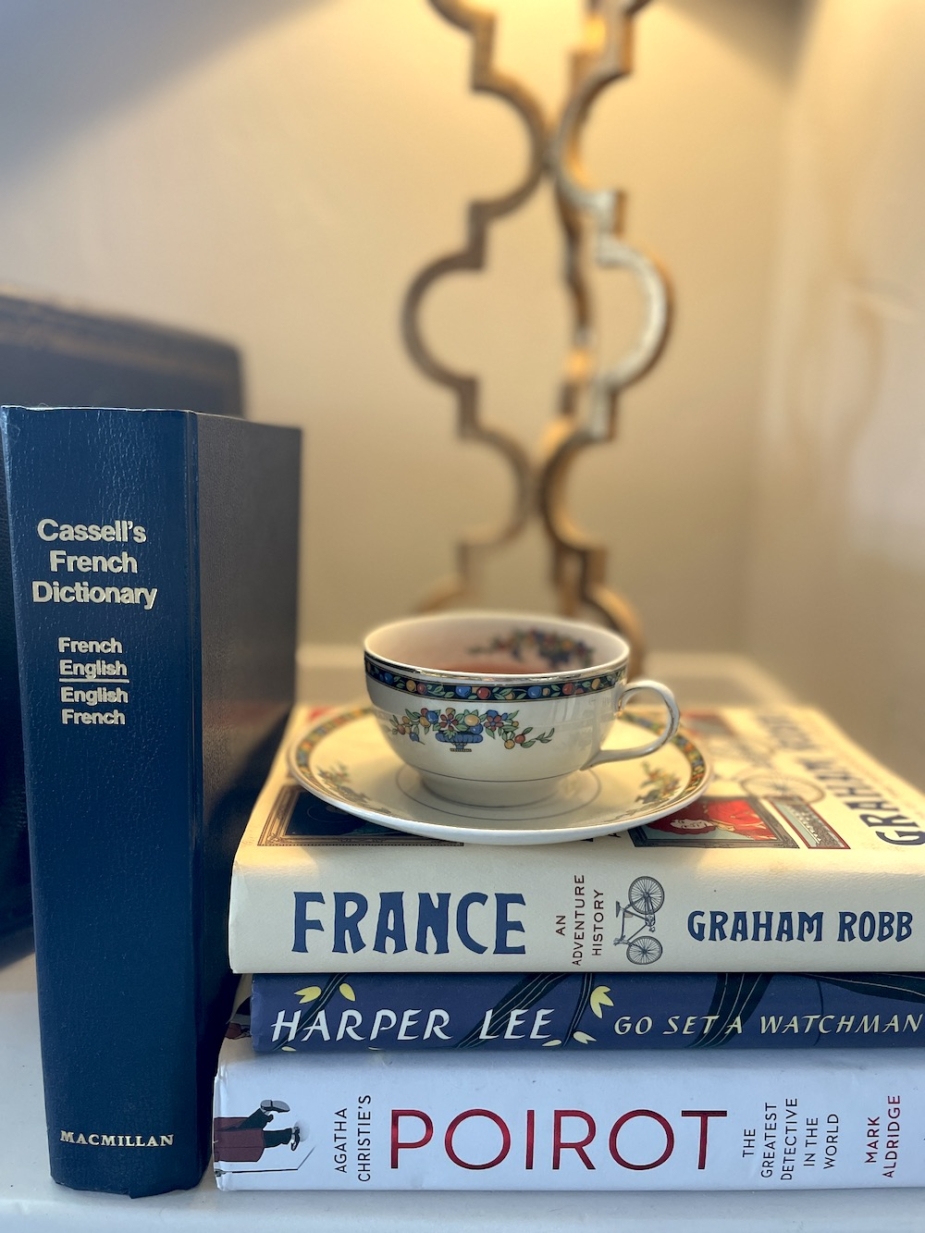 A tidy sanctuary creates mental space to find calm more readily. Upon walking into my home, Le Papillon, knowing and then witnessing that it has been cleaned, tidied and unnecessary items have been removed, whether that be emptying the recycling basket in the boot & basket room (aka mudroom), countertops are cleared of extraneous items, and the flowers are fresh, I breathe some of the deepest breaths I ever take during my days. Distractions to the mind come into our lives in a variety of ways (I share and discuss 11 forms of distraction here), and one such way is clutter of items in our homes, items without a home, too many items, dusty, dirty, disorganized spaces, counters, windows, fabrics, floors, etc. No doubt, I am not sharing anything you don't already know. But how do we tend to our homes and still have time and energy to live the lives we want to live? I will admit to being nearly totally in alignment with Simone Beauvoir's train of thinking shared in her book The Second Sex when it comes to house cleaning, “Few tasks are more like the torture of Sisyphus than housework, with its endless repetition: the clean becomes soiled, the soiled is made clean, over and over, day after day.” And if there was a magic wand to wave whenever the house needed its regular clean and tidy, I would wave it without hesitation regularly and often. I recognize that some may find calm in the practice of cleaning, and that is fine; however, what would you do if your house was perpetually clean? Think of all the time and energy you would have remaining to do something constructive, explore a curiosity, read a book, rest your eyes after a long, grueling, yet productive week, spend more time with those you love, spend more time in your own company getting to know yourself better, take a longer walk with the pups, snuggle with your cat who is seeking your company after having been at the office all day. I share the possibilities of what we might choose to do with more time, regular time consistently available, to point out that while cleaning and caring for our homes is a necessity, there are many different approaches to doing so well to gain the benefits of such a space that is our sanctuary. Apart from hiring a regular cleaning service which I have done in the past and may do again in the future, even if they come every other week, or weekly, we still can care for our homes thoughtfully as well as simply in order to enjoy all of the time we find ourselves in our abode. And regarding the choice to focus on a small household, this can be viewed in two ways: whether small in square footage or living with only a couple of inhabitants (our furry companions count as family here on TSLL). So whether you live on your own as I do, with dogs or cats or entirely in your own company, with your partner, or are an empty-nester, living in a small household liberates us in multiple ways, and thankfully, requires less to clean and care for, giving us more time and energy to do so well. One of the chapters in my second book, Living The Simply Luxurious Life: Making Your Everydays Extraordinary and Discovering Your Best Self, goes in to great detail about “Living Small”, chapter 13, and one such reason is the reality that the smaller the space we call home, the less we have to clean. However, just because we may live, choosing to or not, in a small home doesn't mean the home can't be luxurious. In decoration, in organization, in consideration for everything, we can live luxuriously in a small home, and the beauty is, we have an advantage, we have less to clean, less to furnish, less to organize, now we just have to figure out how to do so wisely and with great savvy. Back in 2011 I shared a brief post detailing what to clean and how often throughout the year in our homes, pairing with the post a free printable PDF of this cleaning schedule, but it was brief and that was more than 10 years ago, so with the prompting from a TSLL reader recently who shares her home with her husband and pets, sans children (similar to myself, sans the husband), I wanted to update and share with you how to clean and maintain your home throughout the year so that when Spring does roll around you don't feel overwhelmed by the 'spring cleaning' fever that often arises. And I completely get it. It feels good to freshen up the entire house, but I don't have the time and energy to do so all in one swoop once a year. Rather, what makes sense to me is a steady, smart approach both in how and what I clean and maintain to avoid large repair bills due to lack of attention. Let's take a look at the list, and I will provide again, but this time the updated version, the free printable PDF schedule at the end of today's post/episode.
1.Begin with a home and its contents that you actually use and need In other words, this is a one off, not a regular practice, but something to keep in the back of your mind after you tend to it when considering bringing in new items to the home. Ask yourself the following question: “The stuff you own has to help you create the life you want. And if it doesn’t, why is it in your home?” –Peter Walsh As I look around my own home, small in square footage but large to the eye with its high ceilings and multiple south-facing windows letting in oodles of light, I will tend to this question room by room throughout the year. Honestly, nothing is on a schedule now when it comes to this permanent editing as I have edited quite a bit over the past four years with my move to my home and with the construction over the past three years. For example, my kitchen cupboards and drawers received a thorough edit during the kitchen remodel when everything was removed and stored in my guest bedroom. Nothing says, reduce and eliminate the unnecessary when you have no more floor space in your guest bedroom to put anything. Do I really need that [insert item that I have never used, not once, ever]? Below is a list of space, collections and items to seriously look at and judiciously edit:
Now that you have clarity that you either have what you need, or know what you need and have let go of the rest, you have let go of some stress, alleviated some unwanted burdens on your ability to relax when you arrive home and are ready to more swiftly and intentionally clean your home regularly without it becoming overwhelming, and maybe even a bit enjoyable. ☺️
2. Daily simple habits that reduce the amount of weekly and monthly cleaning When we are at the point of burn-out even the simplest task of picking up after ourselves can be taxing. I can remember more nights than I want to admit while I was both teaching and blogging that I was too tired to entirely pick up the kitchen after cooking dinner before I went to bed. I literally needed more energy and going to bed was a necessity over cleaning the kitchen. Don't worry, I would without fail, clean the kitchen in the morning, but that was a task that didn't help to begin the day well. Stepping into a clean kitchen, a clean home each morning is a wonderful way to start the day and I knew that, but I did not have the energy to make it my regular practice on certain days of the work week. All of this built up to show me that I needed to make a change, so I share all of that with you to acknowledge, you may have an extremely busy schedule, so much so you cannot tend to these tasks listed below each day, but when you do make the necessary breathing room in your life to tend to these habits daily, it has a beautiful ripple effect of reducing stress, increasing clarity and giving you the ability to make better, more constructive decisions so that you never find yourself in such a schedule again.
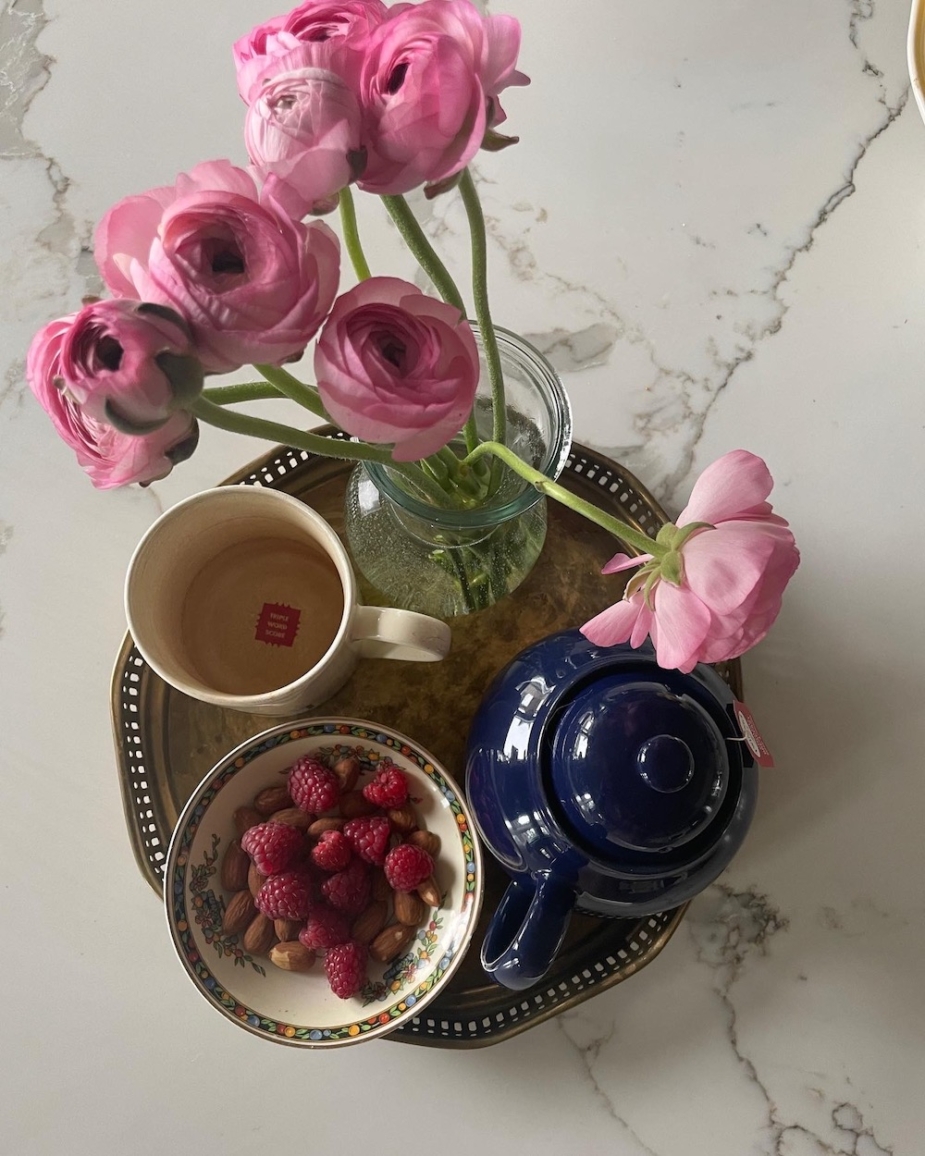 Okay, so what are the daily habits? In order of the day's events:
3. Choose one day during the week, an afternoon or morning (early or late), that you can designate 1-2 hours to clean Now, again, I am not someone who enjoys cleaning, and when I used to write this task in my planner, I sighed a bit because I would have rather been doing something else, prior to retiring from teaching, it would have been just having more time to relax at my home, now it is time to create, to explore, to be with my pups without a vacuum or a cleaning rag/mop in my hand. However, #3 on this list is a be a misnomer because you don't have to do all of the same cleaning tasks each day of the week, rather you are going to alternate a few. Let me explain. It was an aha moment for me the first time I hired a cleaning service to regularly clean my house: they came every other week. And I thought to myself, how can I possibly wait two weeks to have my house cleaned? After all, for years I had attentively cleaned my house each Friday after work, no matter what I was up to later the evening or how long my week had been. Well, what I discovered was that if you clean it well every other week AND tend to the daily habits shared above, your house will be just fine, and you will be less stressed and have more free time. What to do each week (every other week tasks designated as such):
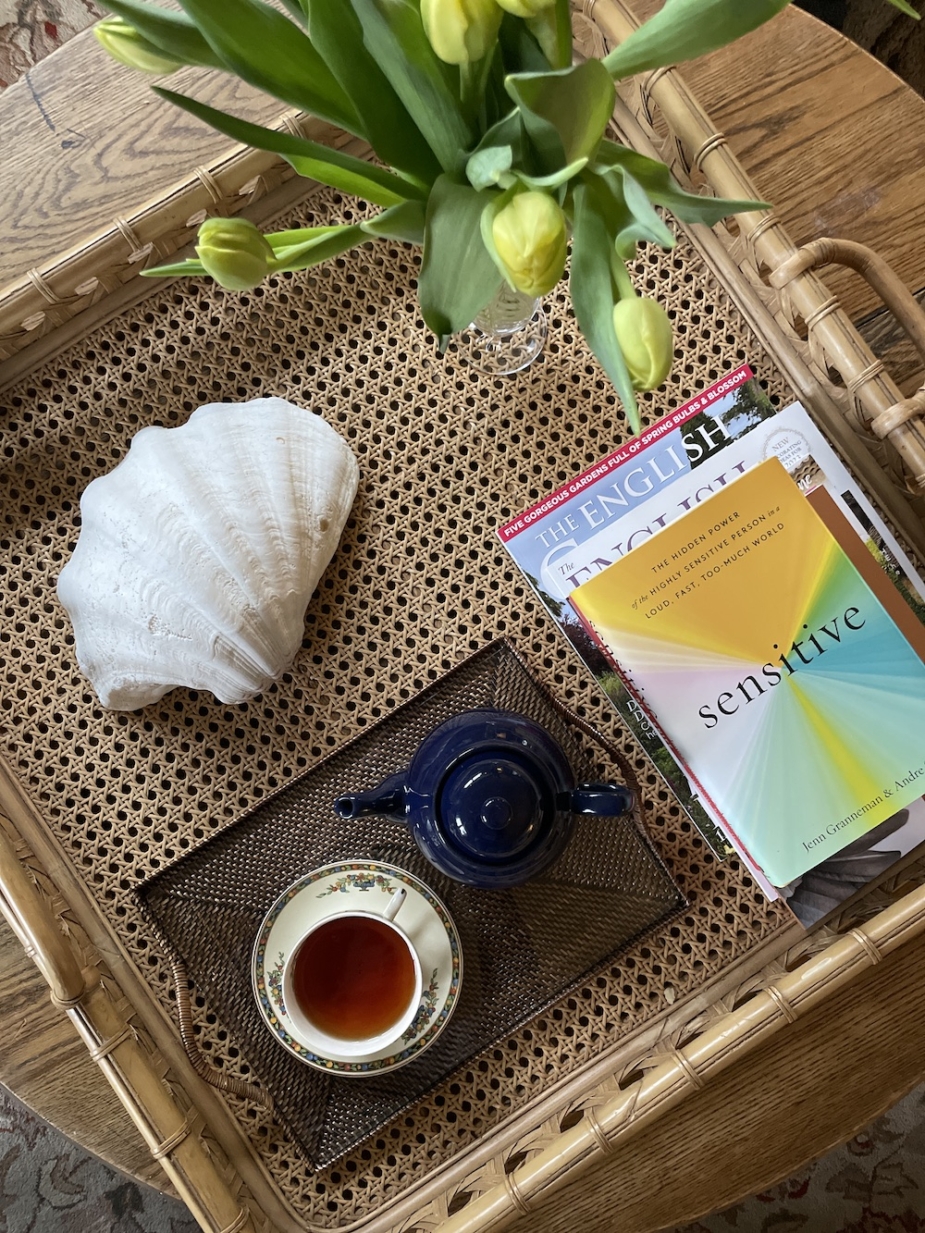
4. Quarterly/every 3 months/Seasonally Many of the items on this list will come from tasks shared in #3 that don't need to be done as often depending upon how you live, or need to be done more frequently that are listed below in #5.
5. Twice a Year, during a day or couple of days that you have energy, so ideally after a day you have been able to rest One time of year I tend to many annual or semi-annual tasks is during the week between the years, that final week of the year when I am able to have time to myself and just rest, then be energized to tidy up which always feels good upon going into a new year. Here's the list:
 ~Nelle was my helper cleaning the interior of my stove recently. Learn more about why I chose Le Cornue for my stove here.~ ~Nelle was my helper cleaning the interior of my stove recently. Learn more about why I chose Le Cornue for my stove here.~
6. Yearly as the time is right on the calendar/season for each task and your schedule The yearly tasks will be dependent upon your home, climate, and other variables, but whenever you tend to what you need to, choose a time that works with your schedule, budget and the best time of year to tend to this task, if it requires, for example, you to be outside.
Phew! Okay, just looking back at this list may seem like a tremendous amount; however, when what you are taking care of are items and spaces in your home that bring you comfort, calm and repose, it becomes motivating to keep them at their best which is why I began with #1. When we remove what feels like a burden because we never use it, it simply takes up space or holds memories we don't want to revisit, then tidying up does become more of a chore. Once #1 has been taken care of, and you spread out all of these tasks over a year, it actually isn't that bad at all. In fact, while compared to the list I wrote in 2011, this list is quite extensive, due to the fact that I have a far smaller house (nearly half the size) than I did when I wrote the previously list, all that I do is far less and done far better which ensures that I can space out the time between tasks or when I do them more frequently, not have that much work to do. Compiling this list occurred on a wonderfully rainy day here in Bend which gave me much time to reflect on a year's worth of responsibilities, but also, as I wrote each one, I was also expressing gratitude, thankful to have a home to care for well. Which leads me to my final idea for creating more enjoyment of the task of caring for our homes, why not name your home? I know it may sound silly at first, but when we humanize the space that gives us life, safety, security, comfort, nurtures love and care, it reminds us that is more than four walls and in a way, a part of our 'family' so to speak, and that too helps in providing an internal motivation to care for it well. And with that to ponder, wishing you a wonderful start to a brand new season with Spring’s arrival next Monday, the 20th. 😌 ~Click here for the free PDF TSLL Cleaning & Home Maintenance Schedule~ ~Learn more about the benefits of becoming a TOP Tier Member.
SIMILAR POSTS/EPISODES YOU MIGHT ENJOY
10 Ideas for Reveling in the Spring Season, episode #325 
Petit Plaisir —Palais des Thé's Herboriste (herbal/tisane) Thés

|
Tue, 28 February 2023

"It's not a matter of luck or magic. This is simply how your brain works. So take a break every now and then, and let your brain do what it does best."—Michael Hyatt & Megan Hyatt Miller, authors of Mind Your Mindset: The science that shows success starts with your thinking One of the Beatles most (of many) famous songs came to Paul McCartney simply upon waking up in the morning. As he did, at the age of 21, he was humming a tune that initially he titled "Scrambled Eggs", is better known as "Yesterday" (source). The founder of Ikea, Ingvar Kampard, came up with the concept that lays at the foundation of the now internationally recognized company - "modular furniture makes home decor more accessible", when while working at a furniture store, a customer who had purchased items for their home could not fit it into their car and had to disassemble the legs from the table in order to drive it home (source). And if you ever wanted to thank the person who made it easy and fuss-free to have your caffeine boost in the morning, thank German Melitta Bentz who, tired of "percolators prone to over-brewing coffee, espresso-type machines leaving grounds in the drink, and linen bag filters being tiresome to clean" came up with the drip coffee machine using "blotting paper from her son’s school notebook". Patented in 1908, her grandchildren continue to head the "Melitta Group KG with some 3,300 employees in 50 companies" all for a simple idea that no one had thought so simple before: patented under the title “Filter Top Device Lined with Filter Paper”(source). Aha Moments can pertain to any number of areas of our world and lives. Yes, they may prompt us to come up with a promising business idea, much like Sara Blakely and Spanx, but more often, aha moments are seemingly out-of-nowhere discoveries that pop up in our minds that give us clarity, insight and/or direction about something that speaks to our true self. Webster's dictionary underscores and elongates the enumeration of what we are gifted with in such moments: a moment of sudden realization, inspiration, insight, recognition, or comprehension. And I don't know about you, but these moments, these Aha Moments with a capital "A" and "M", are a thrill to experience. The dopamine no doubt floods our minds and the joy and lightness in our step feels spontaneous. We figured it out! What ever the "It" might be. Who wouldn't want more of these moments? And the exciting news I want to share with you today is that you can cultivate an environment - i.e. your daily life - to do just that. In a new book Mind Your Mindset, authors and husband and wife Michael Hyatt and Megan Hyatt Miller share neuro-science and psychology research that demonstrates the power of the stories we tell ourselves and accept. Mind you, not all the stories we tell ourselves are constructive, least of all always accurate, and so for a portion of the book, they examine and reveal how to change the stories in our mind to live a more fulfilling journey of discovery and success. Which brings us to Aha Moments.
In order to change the stories that are limiting us from realizing our full potential and experiencing all that life can be when we gather up our courage to engage fully and with our true selves, we have to rewire our neurons, and without getting too complicated, we have to start thinking new thoughts. The authors go on to explain that while oversimplified, the brain does have a division of left and right (even though, not physically divided as each communicates with the other, which is how Aha Moments can occur). Explained as the left side being the executive network side which guides our conscious self, "it thinks about what you tell it to"; the right side is the default network side which "loves novelty and creativity and operates largely in your subconscious". Understanding this construction and function of the brain is crucial to enabling more Aha Moments to be a part of our daily life. Why? "To find creative solutions to your problems you need to get this second part of your brain [the default network] into action. This vast network of slower-firing neurons is highly adaptable. It can be endlessly reconfigured to provide new thought and connections. Sure, this takes longer than using conscious thought [executive network], but it's highly effective." —Mind Your Mindset Which leads us to revealing the answer to the question: How to experience more Aha Moments in your life. Let's take a look at the list below. 1.Consciously choose to not be physically 'working' all the time. Often work is only deemed as work if we can see something changing physically - so physical labor, cooking, cleaning, drawing, writing, correcting papers, etc. However, even Leonardo da Vinci took regular moments, even days to not be physically working on The Last Supper, but that didn't mean he wasn't working. His mind was busily meandering, not necessarily being directed by his left brain, but giving space and time to just meander about all that he held in his subconscious, letting his right side of the brain gradually discover connections that on the surface might seem completely disparate.
2. Make time for tasks unrelated to the 'problem' and somewhat quotidian, give you full attention to what you are doing - in other words, mono-task From walking, to cooking, to eating a meal to savor, gardening, any task that requires your full attention that you can let yourself get lost in and thoroughly enjoy, but is unrelated to the dilemma or question you are trying to answer, engage in it regularly. Seemingly out of nowhere, ideas will arise, but not if we force them to, and while not every time, you are giving your subconscious space to move about because your left side of the brain is taking a break.
3. Exercise vigorously (I will let you define what vigorous is) The reason I include the adverb vigorously is because when you are fully engaged with your workout - a long run, a cycling class, a yoga class, climbing a wall, swimming at a swift pace - your mind is held in the present moment which actually lets your subconscious dance about, yep, wander and meander seemingly aimlessly, but what it (your subconscious) is actually doing is very helpful. You just need to give it space to do that work and the time to connect any dots that you, your conscious mind, cannot see or understand.
4. Take a nap I was going to include this idea in #2, but it is quite different in the sense of being conscience. Similar to a good night's sleep, taking a nap. You will wake up with sharper ideas and a clear mind. On the topic of a good, deep sleep (at least 7-hours), such a regular health habit is vital to being able to experience Aha Moments. As we know while we sleep, our brain is 'cleaned' of toxins, certain thoughts are moved to long-term memory while others are swept away or taken deeper into the subconscious as deemed unnecessary for the conscious tasks we regularly tend to. There are many people, myself included, who go to sleep at night with a question about a particular situation and wake up with ideas anew for best approaching it, OR go to sleep with a worry and wake up having completely forgotten about it because the mind, based on our past experience and habits, deems it unimportant. Phew!
5. Prioritize Play In 2017 after reading Alex Soojung-Kim Pang's book Rest: Get More Done by Doing Less I was inspired to write episode #137 of the podcast and disspell the idea that we must always be 'doing' in order to live a fulfilling and even, dare I say, productive and successful life. What Pang points out, along with so much more is that rest need not be sitting on the sofa (although it can). Rest includes giving our mind (in this case, our left-side) a break and letting ourselves play, have fun, and return to many activities that we enjoyed as a child. In Dr. Mike Rucker's recent book The Fun Habit, he concludes, "If you want a twist of fate, start twisting. Choosing fun every day in small, seemingly superficial ways can, over time, lead to new patterns of behavior—new and better choices."
An Everyday Necessity: Deliberate Rest, episode #137 
6. Enjoy a 'Lazy' Weekend or Day Regularly One of the direct points addressed in Mind Your Mindset regarding stories is what or how we should live, and all of the ideas, in any culture, are rooted in stories we accept. So often the image is presented, at least it was to my generation in our youth by our parents and grandparents that sitting in front of the 'boob-tube' was akin to being lazy. Now don't worry, I am not advocating for plopping ourselves down regularly for hours and days and weeks on end mindlessly watching whatever, but sometimes, we need time to sit down on the sofa and just rest. To physically not move and peruse magazines, books, newspapers, watch something or having something on in the background, listen to podcasts endlessly, the latter two we may not really be paying attention to, but it creates an environment urging us to just be still. And when we are still, when we rest, when we are idle physically with no directive for our mind to attend to or a task to complete, the right side of the brain becomes quite happy and starts to make connections or attempts to make connections to see what might be possible. The authors in Mind Your Mindset suggest if you are trying to figure something out, you can point your mind in the direction you wish it to figure out, but then you let go. Let go and go about relaxing and toodling about with no objective in mind and what you are enabling is something quite constructive. So long as you do this regularly, your mind will begin to offer you ideas that seem initially as if they came out of nowhere, but you and I know differently. :)
Last but not least! 7. Feed your mind with a diverse serving of ideas and experiences The only way, unique and awesome Aha Moments can come to the forefront of your conscious mind is if you continue to remain curious about life. Since you were a child, you have been exposed to a vast breadth of ideas, objects, experiences, people and information. As an adult you have agency to choose to continue to explore new ideas, to deepen your learning, to see new places, experience new cultures, food and anything that is not part of what you already know (or think you know). By choosing to feed your mind with constructive nourishment, even if you don't know what you will do with the 'food' you receive, your subconscious holds on to these moments, and that is what it is dancing about with as you engage with each of the previous six ideas shared above. Which also means, mind what you feed your mind. Be conscientious about what you are exposed to, the information that swirls about, the words that are used, the attitudes, energy, etc. All of this will determine the quality of your life, and when you then make space to exercise your right-side of the brain, beautiful and what may have once seemed impossible discoveries will be made, and your life will change.
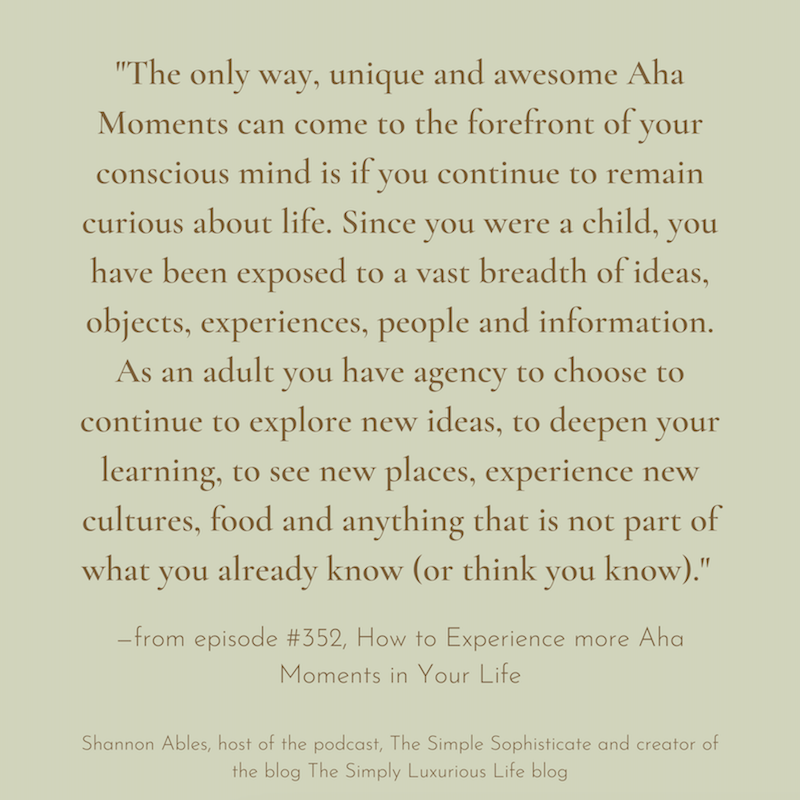 Wishing you many Aha Moments in your near and distant future.
Petit Plaisir
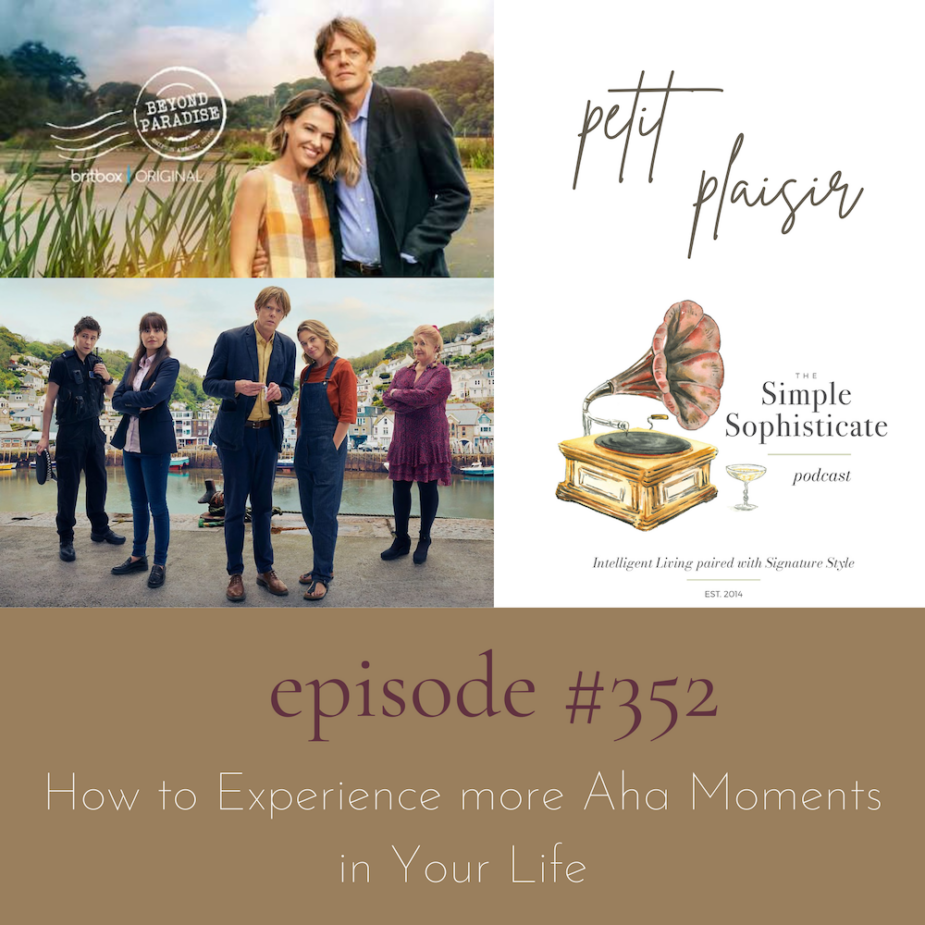
|
Tue, 14 February 2023
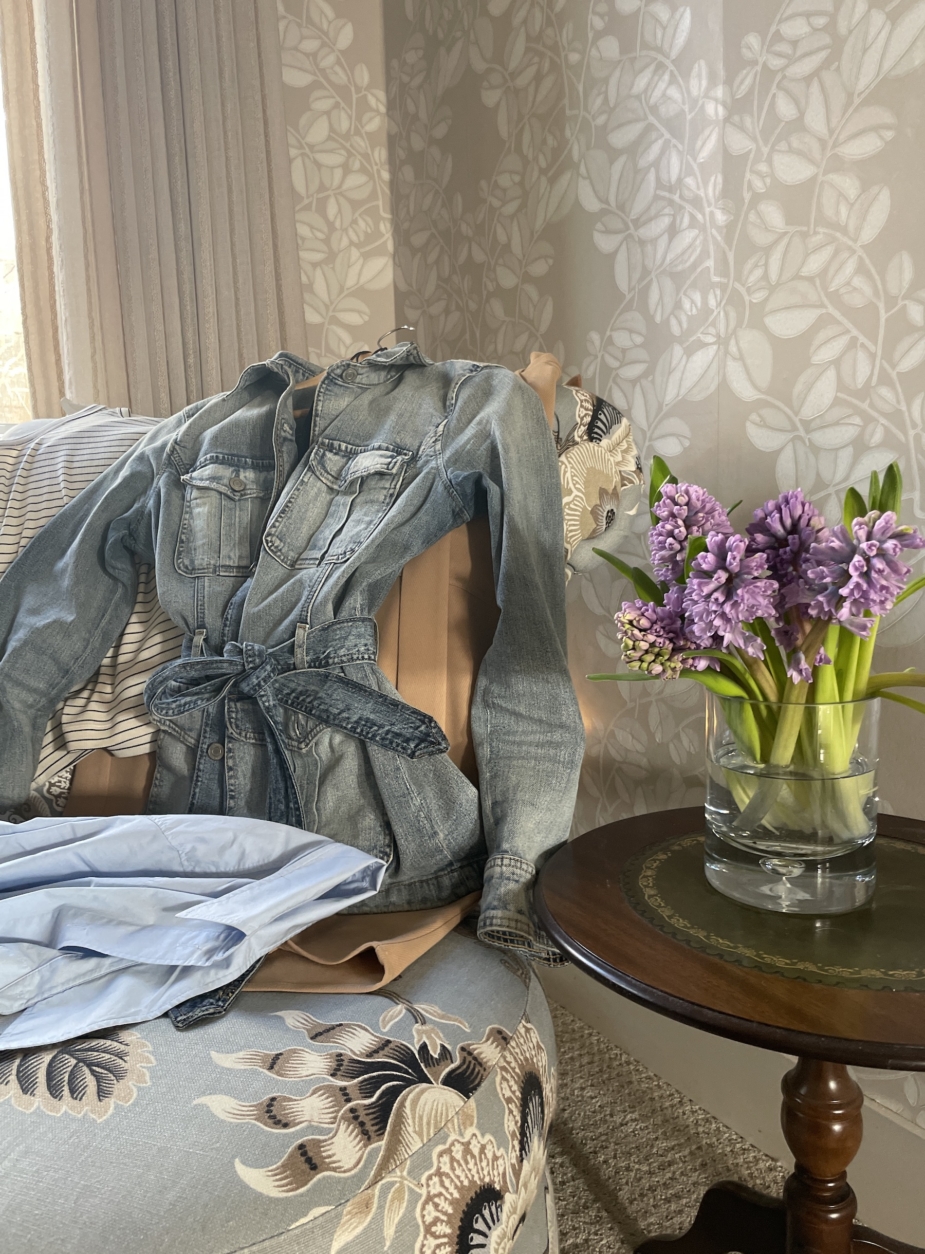 Gabriel. No last name needed, but he doesn't have one if he did, interestingly enough. I'm talking about Gabriel of Emily in Paris fame. Played by Lucas Bravo, Gabriel is the inspiration for today's post/episode because his clothes don't do the talking unlike the rest of the fashion-clad cast, but they definitely don't hinder his appeal. In a recent article in The Wall Street Journal, Ashley Ogawa Clarke spotlights the character's no-excess capsule wardrobe that works to a "T" while he works as an up-and-coming chef in one of the most highly fashionable cities in the world. Sharing that "costume designer Marylin Fitoussi wanted to telegraph that he’s 'more focused on cooking rather than always thinking, How do I look?’" In other words, allowing the clothes support the life he lives, showcase, but not hog the stage. This observation immediately caught my attention as I have found myself shifting when it comes to my own clothing: not away from caring what I choose to wear, but as I become more confident and focused on running TSLL well, choosing a wardrobe that is simple, yet stylish, requires less thought, but looks smart and yet effortless. With the release of TSLL's Annual Spring Shopping Guide arriving soon (March 1st), today's episode/post will share ideas for preparing ourselves for how to be savvy shoppers with clarity about what a Capsule Wardrobe entails without the Excess. To follow Albert Einstein's advice, although I doubt he was referring to wardrobe shopping, "Make everything as simple as possible, but not simpler.” Let's take a look at how to simplify to amplify as we invest in key items for our Spring Capsule Wardrobe:
1.Love a cut/style/length? Buy it in multiples, but in different colors This piece of advice is well-known, but something that Gabriel demonstrates well, but that is not often advised is that the colors for the same style are different. Decide to become a student of your skin's undertones as well as what complements your hair color, and purchase different colors in that same style - a shirt, a pair of pants, a skirt, a dress, a jacket, etc. - that works well with your silhouette, lifestyle and personal taste.
2. Denim just works, so invest in it, buy multiples of the exact same pair, then alter Something that was suggested in the article mentioned above is this idea. When you find a pair of jeans that just work - they are high quality, the wash is spot-on, the waist-height is ideal and the fit remains constant (in other words, not too much stretch) - buy multiple pairs, and then based on the different shoes you wear your jeans with, have certain pairs altered to work well with that particular pair of jeans, so that while the same jean, each has a slightly different look and adds that extra polish from the tailoring. For example, you may want an ankle hemline for the summer and spring when you wear with flats or heels, but a longer hem for wearing with booties in the fall and winter.
3. Find a jacket or blazer that you love and don't stray (buy multiples, in different colors) For me, it is an oversized blazer that I will be hunting down this spring, and in multiples. They may not each be from the same brand, but the style an cut will be the same. The idea here is that you know what complements your style, what works for your lifestyle, so why stray? Just change up the color, change up the fabric to either dress up or down, and go do what you do and pay no mind to what you are wearing (because you look and feel great).
4. Switch up materials Speaking of switching up the fabric . . . keeping it simple without the excess means you apply what you know and you don't add the fluff. A simple slub tee under an oversized blazer with ankle hemmed denim. Done and looking great. Throw your crossbody bag over your shoulder and get about your business. Come the weekend or an evening out, change the denim jeans to crepe pants with the same length and finish, maybe even still a dark navy, similar to your jeans. The blazer and tee still work, but you've punched it up a bit.
5. Find your pop of color and home in on that and nothing else (except neutrals) Something I wrote about in this post last year more generally is knowing what colors work for you and to forget the rest. Keeping in mind that the colors you come up with work with each other, and so to drill down a bit more specifically, stick to neutrals all except one color. And select this lone star color to be a color that complements you without fail. My one color is a cool pink - not pastel, not fuchsia, not maroon - but a cool undertone pink. No other color makes an appearance in my closet as I have learned through past purchases that other colors just don't work for me as well as I thought they might when I viewed them in the store or online. Paired with my neutrals of cream, navy, denim, and camel, that is just about all I wear, and almost everything can mix and match. This may sound boring, but there is no reason for me to attempt to dress like a style influencer or like Emily in Paris or Carrie Bradshaw. I adore each of their courageous ensembles and they look AMAZING, but what I gain from watching them is ideas of what types of items can go together, and then I return to my color palette and rest assured that what I end up purchasing will work with what I already have.
6. Stick to the basics for types of clothing and avoid the trends To relieve any confusion and fret about what to buy each season, walk away from worrying about trying to figure out the trends, and instead return to the basics - basic tees, oversized button-up shirts, blazers, A-line skirts or wrap dresses, knee-high boots, flats - ballet or loafers, blazers, etc. - and within those basics, become the student of yourself and know the answer to the following question: What flatters me? Necklines, hem lengths, sleeve lengths, heel height, waist height, etc. The simplifying of the process makes the decision-making easier, the selection streamlined and therefore you can narrow down what is available for you to choose from without draining your energy flipping/scrolling through item after item after item which is ultimately how frustration builds up - we see more of what we don't want than what we do. When the opposite begins to happen because you have edited out what wouldn't be best for your wardrobe, you feel as though you have ample options and the shopping begins to become more enjoyable.
7. Keep your shoe options to four, with variations Part of the stress of dressing well is often having the shoe we need, so let's simplify that as well. Make sure you have these four types of shoes in your closet, and make sure they are investment - high quality and fit well. (1) a trainer or a sneaker that fits what you need - not too wide, the best material for your lifestyle (canvas or leather, etc.), and a color that will work with your outfits. (2) a pump or heel to your choosing for dress and work - choose the height that flatters your leg and is comfortable to wear in a color (or colors) that work with your wardrobe. (3) a boot - ankle or knee high, determine the heel height for your lifestyle. And (4) a flat of your preference - pointed toe or slightly rounded, a loafer, etc. Begin with ensuring you have one of each, a quality pair of each and then build on that as you discover what will complement your wardrobe.
8. Make selecting quality over quantity your modus operandi At the core of living simply luxuriously is to live a life of quality over quantity in all arenas of our life, and so with our capsule wardrobe, as I have shared many times before, choose quality items. Even if you can only buy one this season, instead of the handful you would prefer, that one, if made well, fits you smashingly and complements your awesomeness is worth the price. Keeping in mind the rule of investment - cost per wear, and let that long-term benefit ease your mind. From boots, to coats, to sweaters and dresses, blazers and camisoles, when I purchase a quality item, it continues to be worn year after year, for years to come. I wrote a detailed post on my first purchase (and only thus far) of a Burberry trench, and while I waited for years to be able to purchase it, it is still in fantastic shape now six years later and it is worn constantly during the spring and fall months. Again and again and again, with advice shared in fashion magazines and even in Masterclass by fashion experts, the advice shared for keeping your wardrobe simple, but stylish is to, yep, you guessed it - choose quality over quantity. Ultimately, what you're doing when it comes to creating a capsule wardrobe that sings but without the excess is investing in multiple versions of the uniform you look your best in and that complements the life you love living.
With all of that said, look for TSLL's Spring Shopping Guide to be available on the blog on Wednesday March 1st where I will shop more than 70 items that are available in the new spring collections and items worth investing in so you will have and wear them for years to come. Ranging from low-mid (J.Crew, Madewell) to mid-range luxury (Theory, Vince, L.K. Bennett, etc.) to a few luxury finds (Net-a-Porter designers for example). As always, you can peruse TSLL's Boutique/Shop where I have shopped and keep updated timeless items for all seasons. On that page - find it in the drop-down menu under SHOP - Capsule Wardrobe - you will also see the past Spring and Fall Shopping Guides shared most recently on the blog.
SIMILAR POST/EPISODES YOU MIGHT ENOY
Petit Plaisir
~The Creative Act: A Way of Being by Rick Rubin
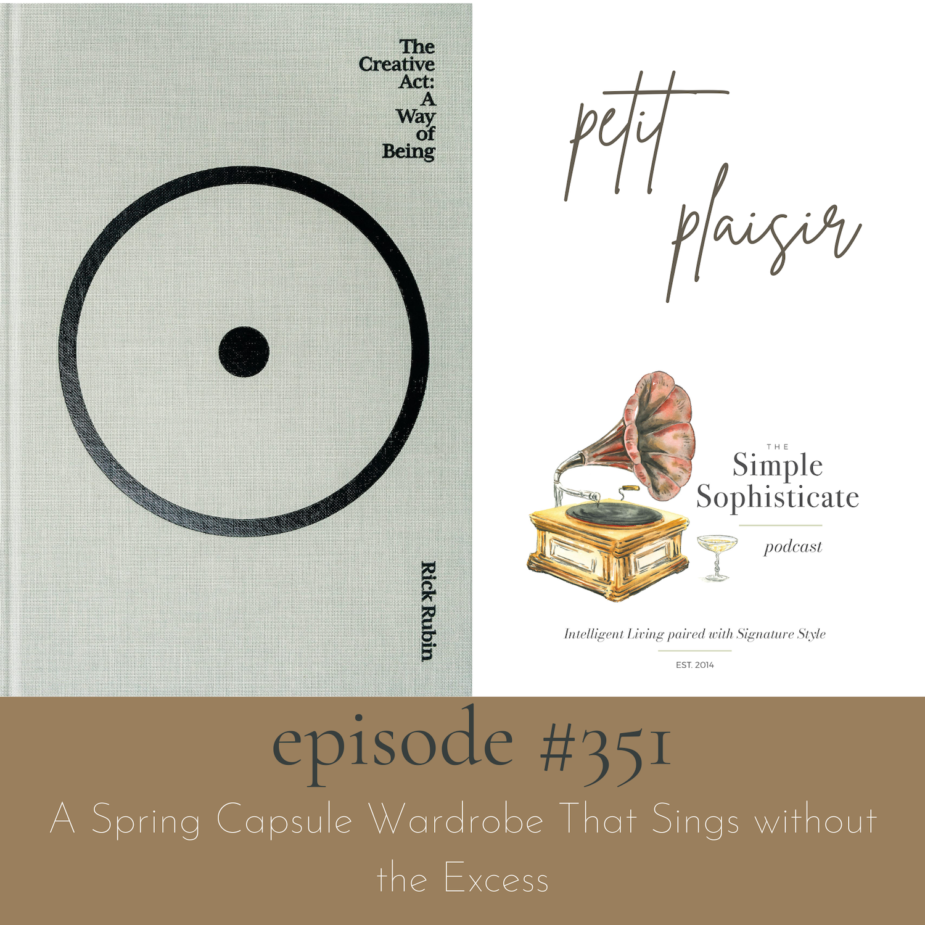
Listen to the Previous Podcast Episode
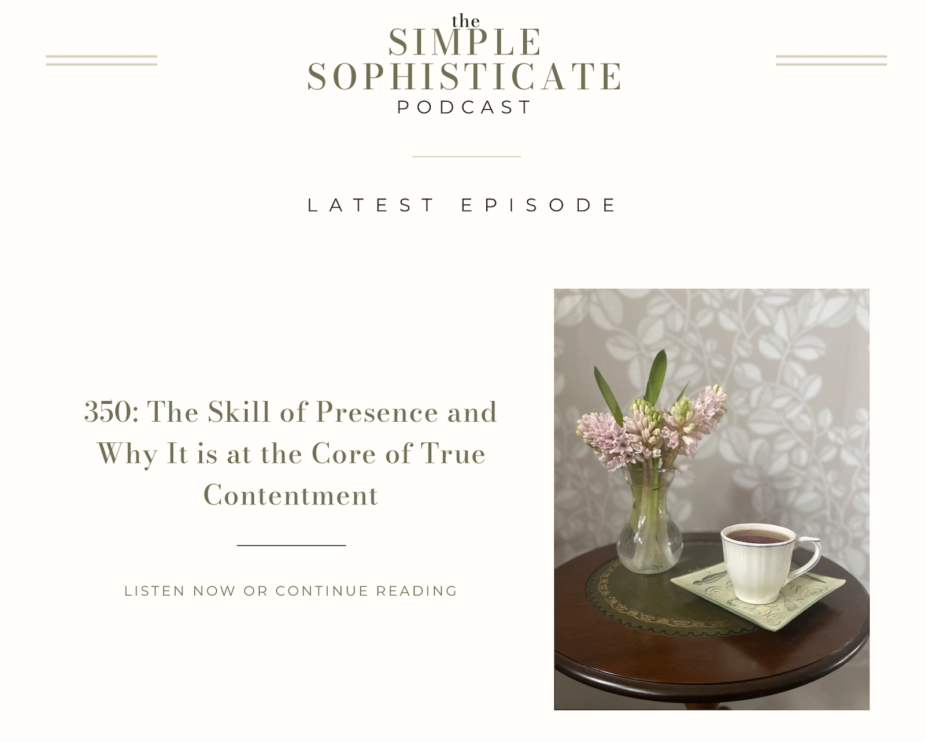
|
Tue, 31 January 2023
"Presence is power." What if I told you that the solution to your quandaries about life, love, work, finding calm, anything of value and importance already resided within you? While initially this may seem impossible, in actuality, when we dig down deep to the core of our motivations, our hopes and even our fears, the answers rest in being able to hold ourselves in the Present moment consciously on a regular and consistent basis. Now this may seem elementary, even a simpleton answer, but today, I want to share with you why indeed it is true. And how exciting to know that what we have been seeking (and not finding) outside of ourselves has been within our power all along. ~The Simple Sophisticate, episode #350 Read the Show Notes - https://thesimplyluxuriouslife.com/podcast350 The Simple Sophisticate is someone who prefers quality over quantity, sensible living over mindless consumption, personal style instead of trendy fashions, has an insatiable curiosity for life’s endless questions and a desire to live a truly fulfilling life rather than being led around by the nose. Inspired by her lifestyle blog The Simply Luxurious Life, Shannon Ables (the original Simple Sophisticate) shares with listeners tips on how to live a refined life on an everyday income. From achieving your goals, preparing a memorable meal, creating a capsule wardrobe, traveling the world (Francophiles and Anglophiles tune in as France and Britain is a favorite destination), and living life to the fullest without breaking the bank, living well is really quite simple. ~Subscribe to The Simple Sophisticate: iTunes | Stitcher | iHeartRadio | YouTube | Spotify | Amazon Music |
Tue, 17 January 2023
"On ne comprend jamais tout à fait une langue avant d’en comprendre au moins deux." It took 43 years for me to finally learn the French alphabet, and when I say learn I mean how to properly pronounce each letter, even after taking French classes in college and then again taking French 102 and 103 back in 2016 at our local community college. After sharing this with someone recently, they looked at me perplexed, but you see I never enrolled in French 101 as it was a fall course, and during the 2015/16 school year I was head-first transitioning into my new teaching position here in Bend, so waited until I was settled with my own schedule to explore French classes. Backtrack to college, as explained in detail in my first book, a similar situation; I began my studies during winter term rather than fall due to a shift in my life journey and needing to acquire the necessary prerequisites to study abroad in French the coming summer. With that said, learning the alphabet, and singing the French jingle to help cement the sounds of each letter into my memory was one of the most exciting and appreciative moments of my novice French learning experience thus far.
Beginning today is a return to the series I began in 2016, so today's episode/post is labeled as Partie Quatre (part four). As I make my way through my courses - a new quarter/course each season - look for future posts/episodes to be shared. You can explore all of my French-themed posts and episodes via the respective links.
The Simple Sophisticate, episode #349~Subscribe to The Simple Sophisticate: iTunes | Stitcher | iHeartRadio | YouTube | Spotify | Amazon Music |
Tue, 3 January 2023
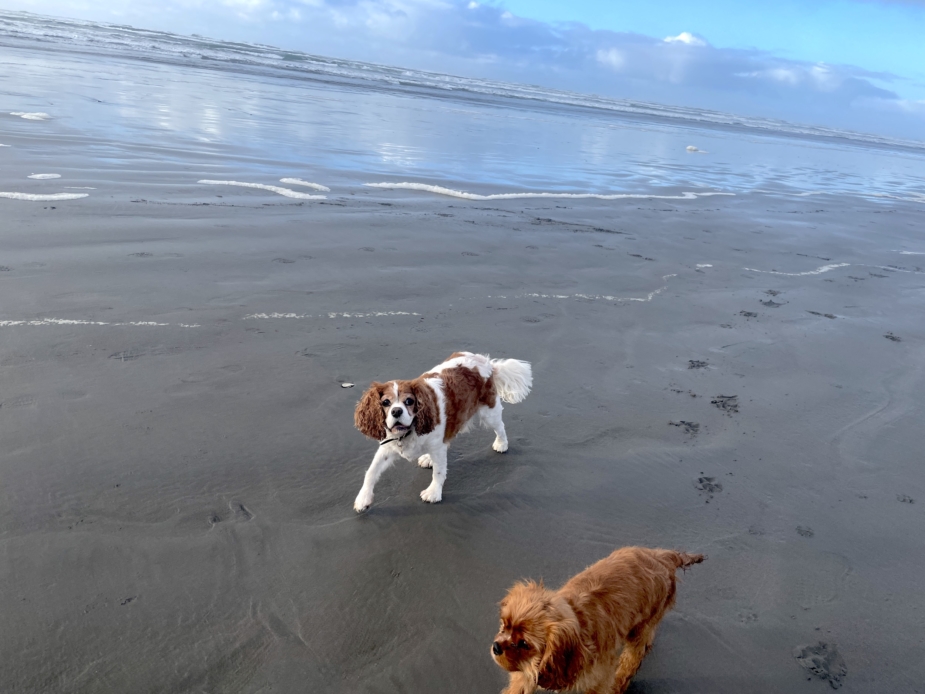
"The greatest gift that manifesting can offer us is not to help us attract things for us to possess but to help us unleash the most empowered, authentic, self-loving, and truly magnificent version of ourselves that there is." —Roxie Nafousi How we live, how we think, what we think determines the destiny of our lives, and all three are thankfully within our control. All three actions - living, thinking, selecting [which thoughts to think] - involve just that, being active rather than being passive. However, the paradox arises when we choose to first actively and consciously engage constructively with each daily practice - thinking, living, selecting - but then, . . . let go and let the magic unfold as it will. When I first picked up Roxi Nafousi's new book Manifest I wasn't sure how she would present the idea of manifesting, but I quickly discovered that she spoke to the core tenets of living simply luxuriously which involve active participation in our lives, deepening our awareness and knowledge of how our mind works and applying that knowledge to tap in to discovering what lies within that is uniquely who we are. In fact, late last year, I wrote a post about self-sabotage and better understanding the temporary discomfort that often derails the life trajectory that will ultimately bring us deep fulfillment, a discovery of insight taught in Nafousi's book. And there is so much more within the pages of the book to inspire you as you step into this new year, so I wanted to give one more taste of what manifesting entails because what it gave me was a sense of peace to let go once I have clarity and am willing to act consciously. To begin with, Nafousi's book is neatly organized around the seven steps, and each play a necessary role in cultivating healthy habits and thought defaults that set you on the right track to create the magic that at this moment may seem impossible. To reiterate, manifesting is not a passive approach to life. "You cannot just be clear in your vision and then wait for it to appear." So what does that mean exactly? Step two in the book centers around eradicating fear and doubt from your life, and she goes into great helpful detail to explain how by allowing fear and doubt into your life, errantly believing that they are your 'friends' is a significant reason you are not manifesting the life you wish to live. As it pertains to being active, Nafousi teaches that we must align our behavior with what we imagine to be our future life and selves as this reveals that we value ourselves, and we have a healthy awareness of our self-worth. If we allow fear and doubt to limit our vision of our life, then, as she describes, 'the universe won't believe you believe what you say you deserve." And this is where the hard work comes in. So you want to pass the bar exam? You cannot just 'think' your way to passing the exam. You are going have to study, prepare, study even more, and re-prioritize your time for a duration in order to ensure you are prepared to pass. Want to learn a new language? You are going to have to invest in quality instruction, invest your time, continuing to study regularly and surround yourself with the language as much as possible for a decently long duration of time, but your clarity of what your vision is gives you the road map and helps you to stay focused. Nafousi points out that once you know that path and what it might take to manifest what you envision, fear and doubt may still crop up. How? By way of excuses - "I don't have enough time", "I don't have enough resources [i.e. money, support, etc.]", "I don't have enough energy". Each of these excuses are just that, excuses borne out of fear or doubt. The excuse is a subterfuge for saying "I am not worth what I seek and I don't believe I am actually ready for what I hope for". But here is the good news: If you have done the homework of you, examined the feelings behind what you seek, and know in your core that what you are trying to manifest is sincerely aligned with your true self and fulfillment, toss aside the excuses. Yep, even if you cannot see how the money situation will work to make it a reality. Why? The universe has a magical way of making it work out. Maybe not exactly as you envisioned or when you envisioned it would all come together, but if you are willing to risk and toil and invest your time and whole heart, your sincerity is in many ways a silent language that the universe understands. Stay the course, keep investing (non-monetarily and monetarily), and then let go as you travel forward on your journey. That is the paradoxical part of this beautiful concept of manifesting. Let go.
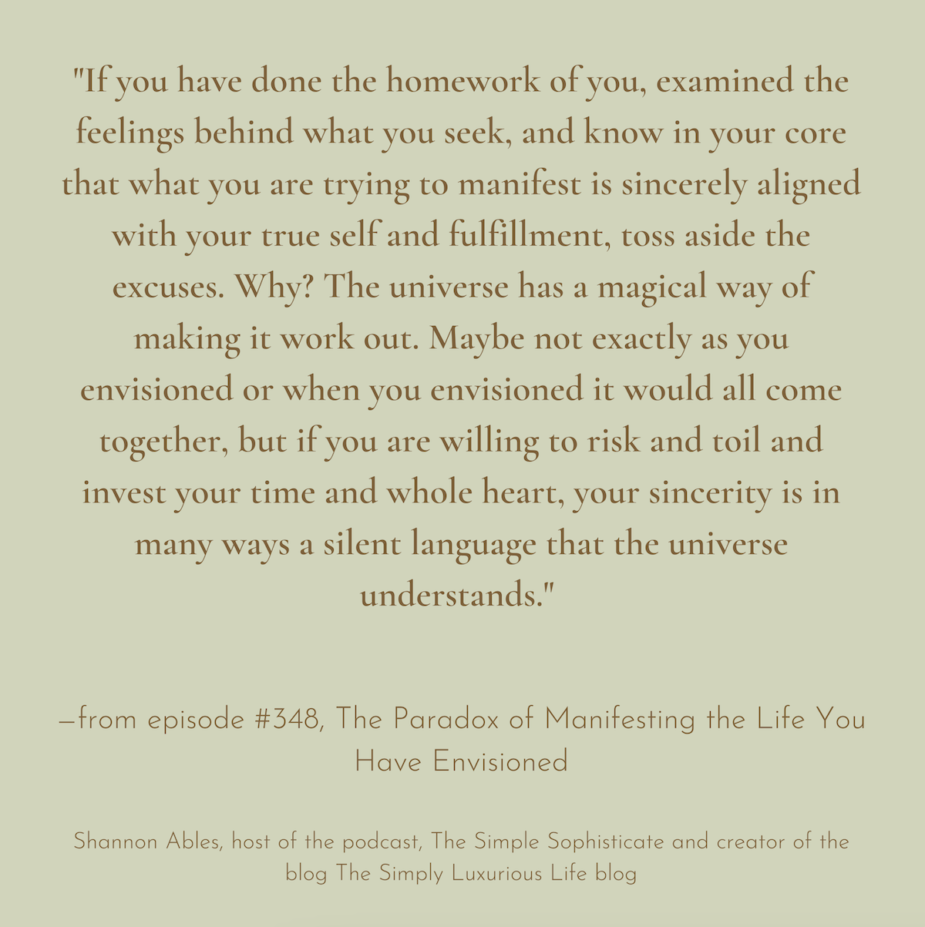 You still remain active, you are still wholly engaged, but what you will find is because you are truly aligned and sincere, the weeks and months, maybe even years on the calendar may flip by, but you are building capital as they say, building further proof that you believe you are worthy of what you are investing in and at some point it seems to all come together, often more beautifully that you could have imagined. But the good news is that you enjoyed the journey to this point as well because that journey was and is your life, just as much as arriving at the moment of manifestation. "True contentment and joy come not from material possession but from the relationships around us; from our sense of purpose; from our ability to live in a way that reflects our most authentic self. So, when you are deciding what you want to manifest, choose the things that will bring you the most fulfillment possible and know that the only person who can decide what that is, is you." —Roxie Nafousi The letting go also comes in the form of "letting go of who we think we should be, who other people expect us to be, and who we once were." During this time of limbo, when you have let go and are swinging forward to a less 'known', but no less specifically desired outcome, there will be tests. These tests are something we have talked about frequently on the blog. These tests crossing your path, believe it or not, come as a good sign because it means you are beginning to grow and change, and the universe just wants to check to see if you indeed believe in yourself. Each test also brings a gift, and that gift is a lesson you need to learn in order to step closer to the outcome you seek. Take the test, pass the test, move forward. You've got this. And the only way to fail the test is to not look for the lesson it wishes to teach you. Simply face the test, engage, explore, try your best, and as Nafousi points out "whenever you make the energetic shift to overcome your test, you will be rewarded with abundance." If that all seems a bit 'whoo-hooey', let me put it in more concise terms: it comes down to your mindset - are you set in a scarcity mindset or an abundance mindset? In a detailed post written this past November, I share how to shift your mindset from scarcity to abundance because in order to live the life you have envisioned, your mind must rest in abundance. And part of making that shift is stepping past the fear and the doubt that wants to keep you right where you are, and the only way to move forward is to engage with each test the universe sends your way and not cower. You may shake a bit, but remain standing and explore what is being presented. You don't have to act right away, but take your time, ask questions, feel your way around what is really going on and what you are really feeling and why. The balancing of taking action and letting go may initially seem a tricky, and almost impossible balance, but really what life is asking of you is to be present. There is no need to rush so long as you have put forward your intention with the clarity that you now have. Sometimes you will have to wait months and years for the materialization, but in a flash, all of a sudden it arrives. Almost so quickly it doesn't seem real and you question it, but rest your mind in the place of reassurance that this is indeed real because you put your intention and your energy out there a long time ago, and finally, the opportunity arose because you let go and moved with the timing of the universe. Seize it and savor it.
Manifest: 7 Steps to living Your Best Life by Roxy Nafousi 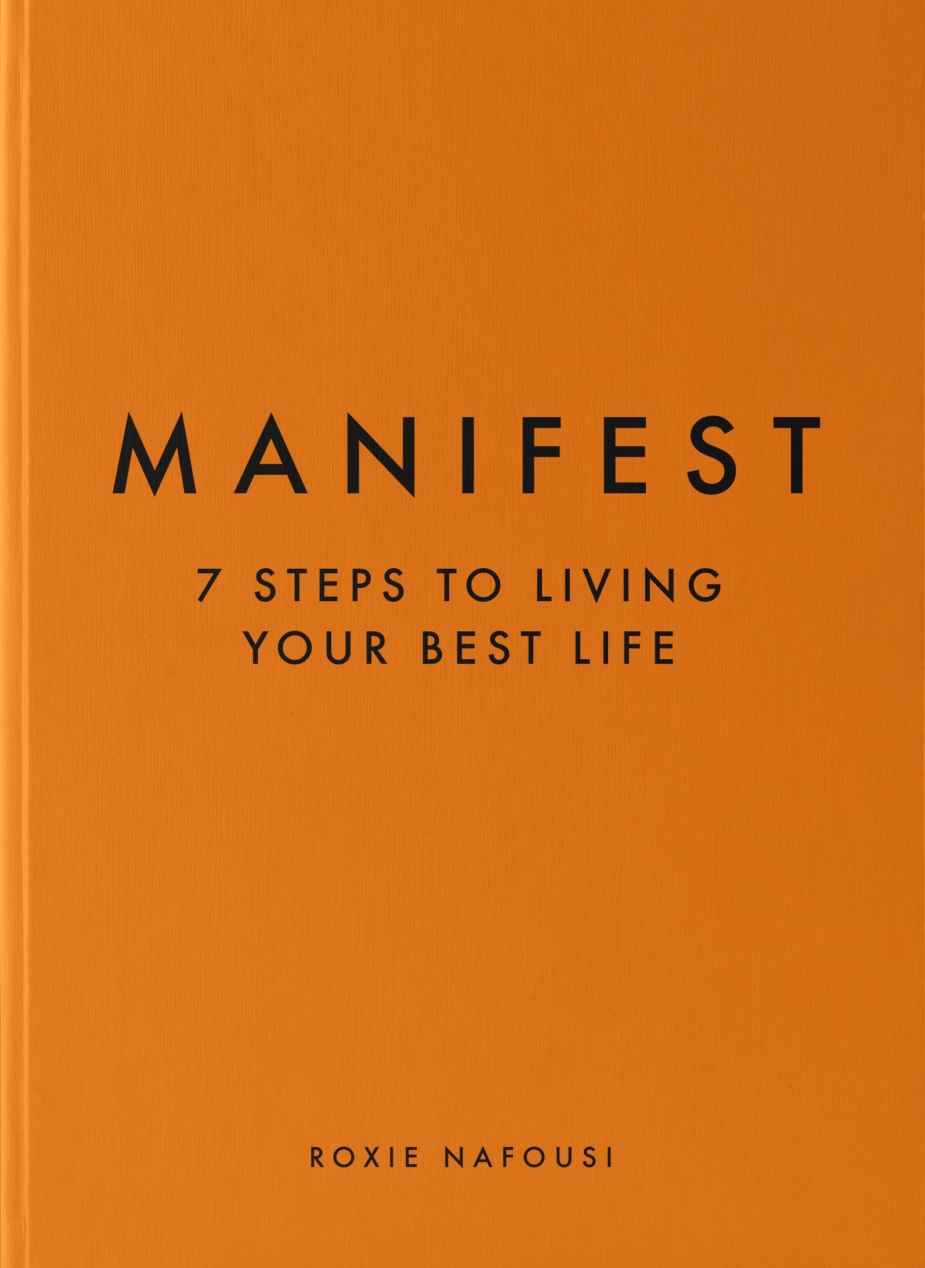
Petit Plaisir This Beautiful Fantastic, film (2017)
 |
The Simple Sophisticate - Intelligent Living Paired with Signature Style

Categories
lifestylemoney
fashion
general
food
relationships
beauty
holidays
style
decor
etiquette
technology
dating
clothing
news
happiness
health
finances
self-help
feminism
french living
communication
inspiration
self-improvement
cooking
French-inspired
podcast
travel
entertaining
Archives
AprilMarch
February
January
December
November
October
September
August
July
June
May
April
March
February
January
December
November
October
September
August
July
June
May
April
March
February
January
December
November
October
September
August
June
May
April
March
February
January
December
November
October
September
August
July
June
May
April
March
February
January
December
November
October
September
August
July
June
May
March
February
January
December
November
October
September
August
July
June
May
April
March
February
January
December
November
October
September
August
July
June
May
April
March
February
January
December
November
October
September
August
July
June
May
April
March
February
January
December
November
October
September
August
July
June
May
April
March
February
January
December
November
October
September
August
| S | M | T | W | T | F | S |
|---|---|---|---|---|---|---|
| 1 | ||||||
| 2 | 3 | 4 | 5 | 6 | 7 | 8 |
| 9 | 10 | 11 | 12 | 13 | 14 | 15 |
| 16 | 17 | 18 | 19 | 20 | 21 | 22 |
| 23 | 24 | 25 | 26 | 27 | 28 | 29 |
| 30 | ||||||
Syndication







